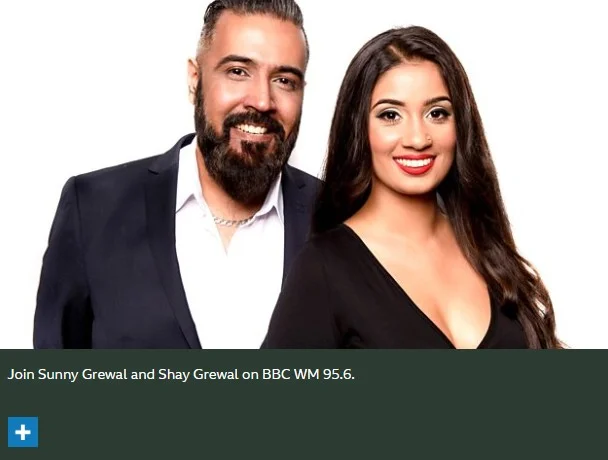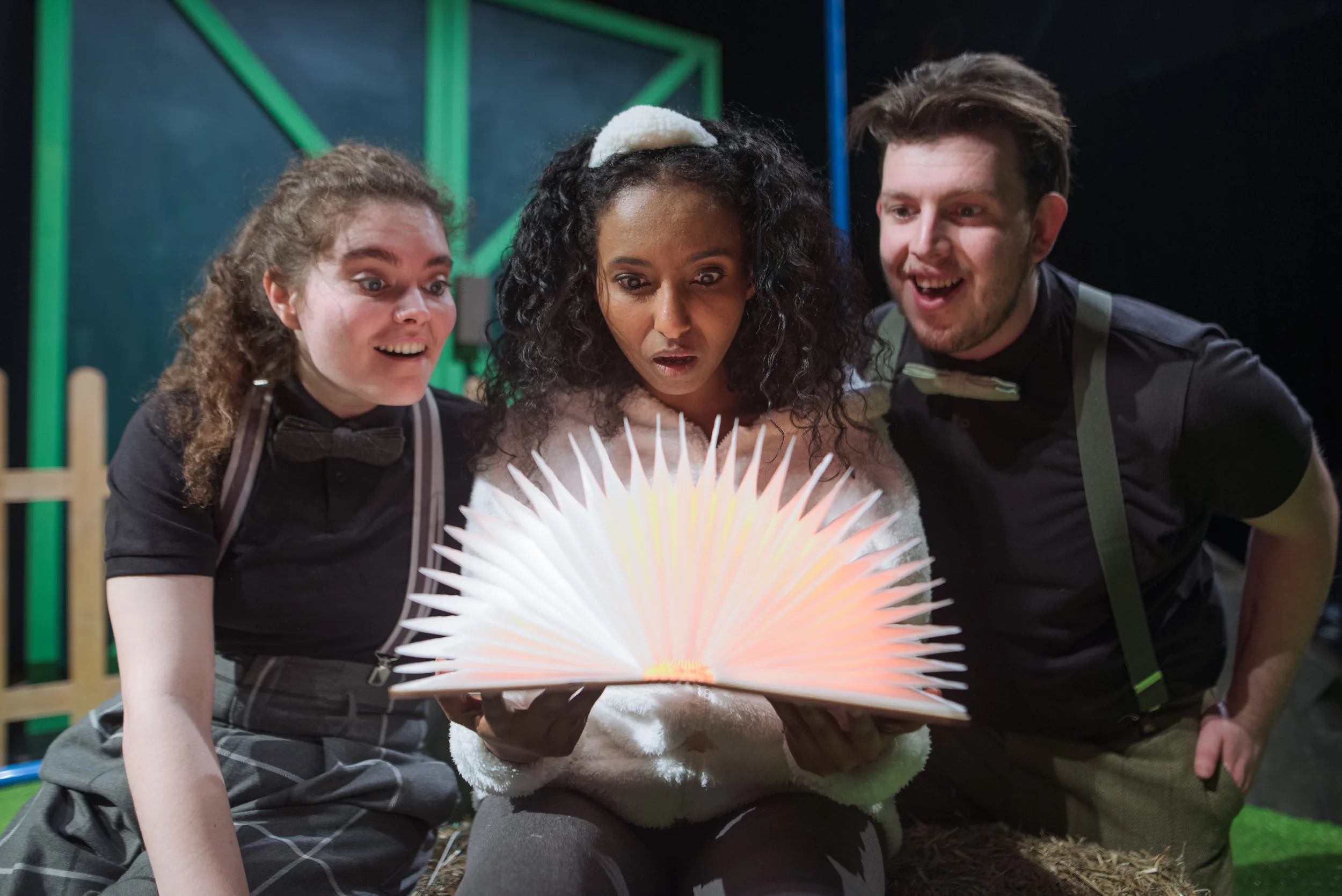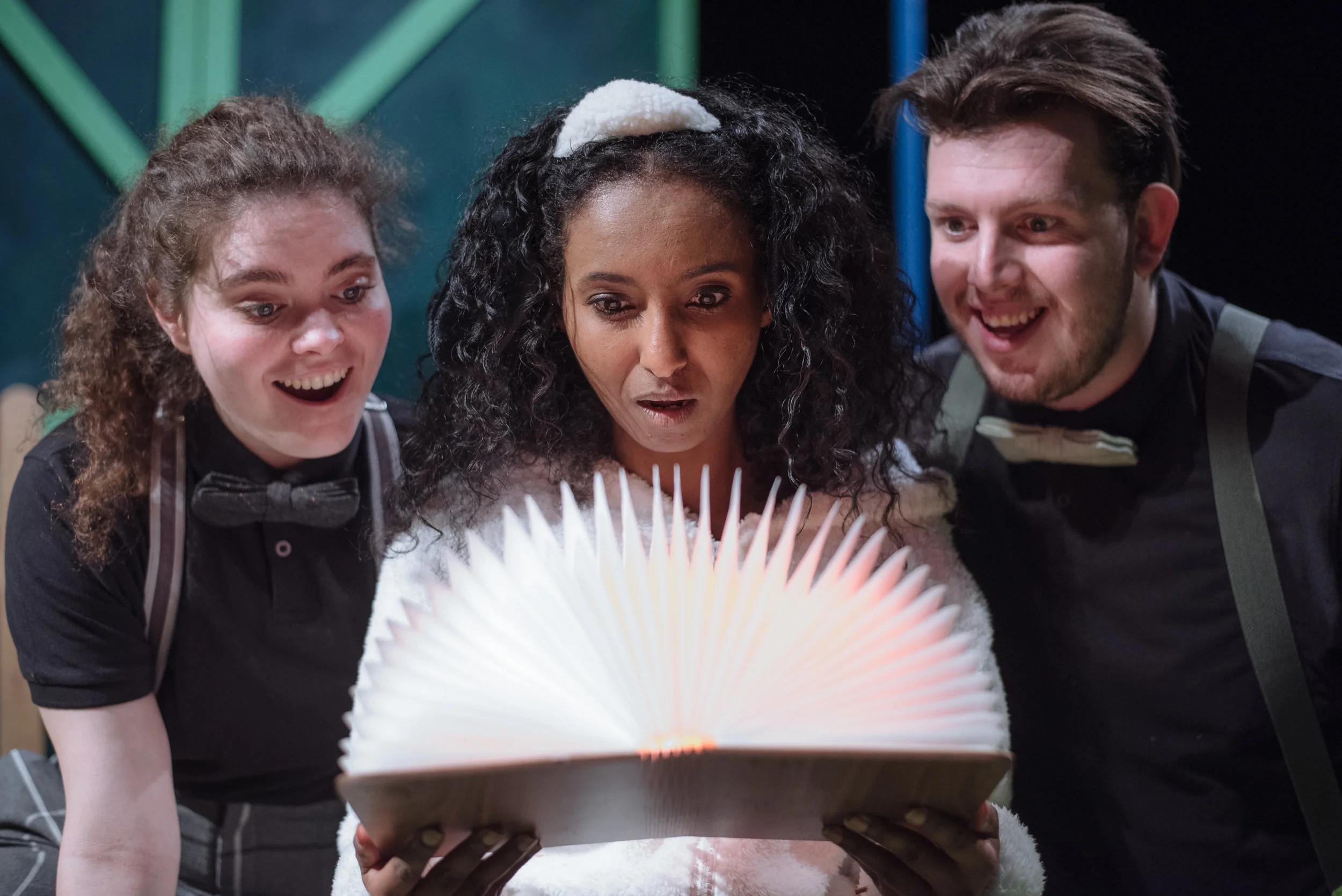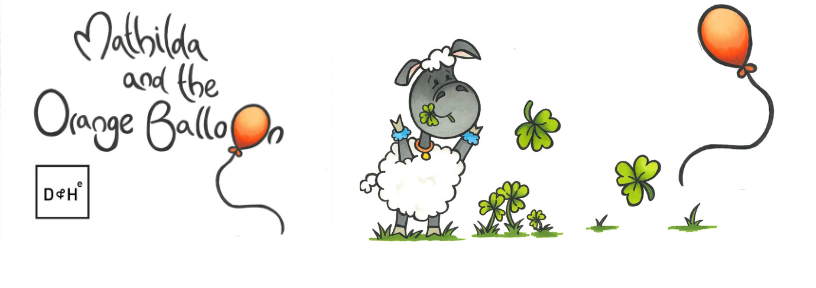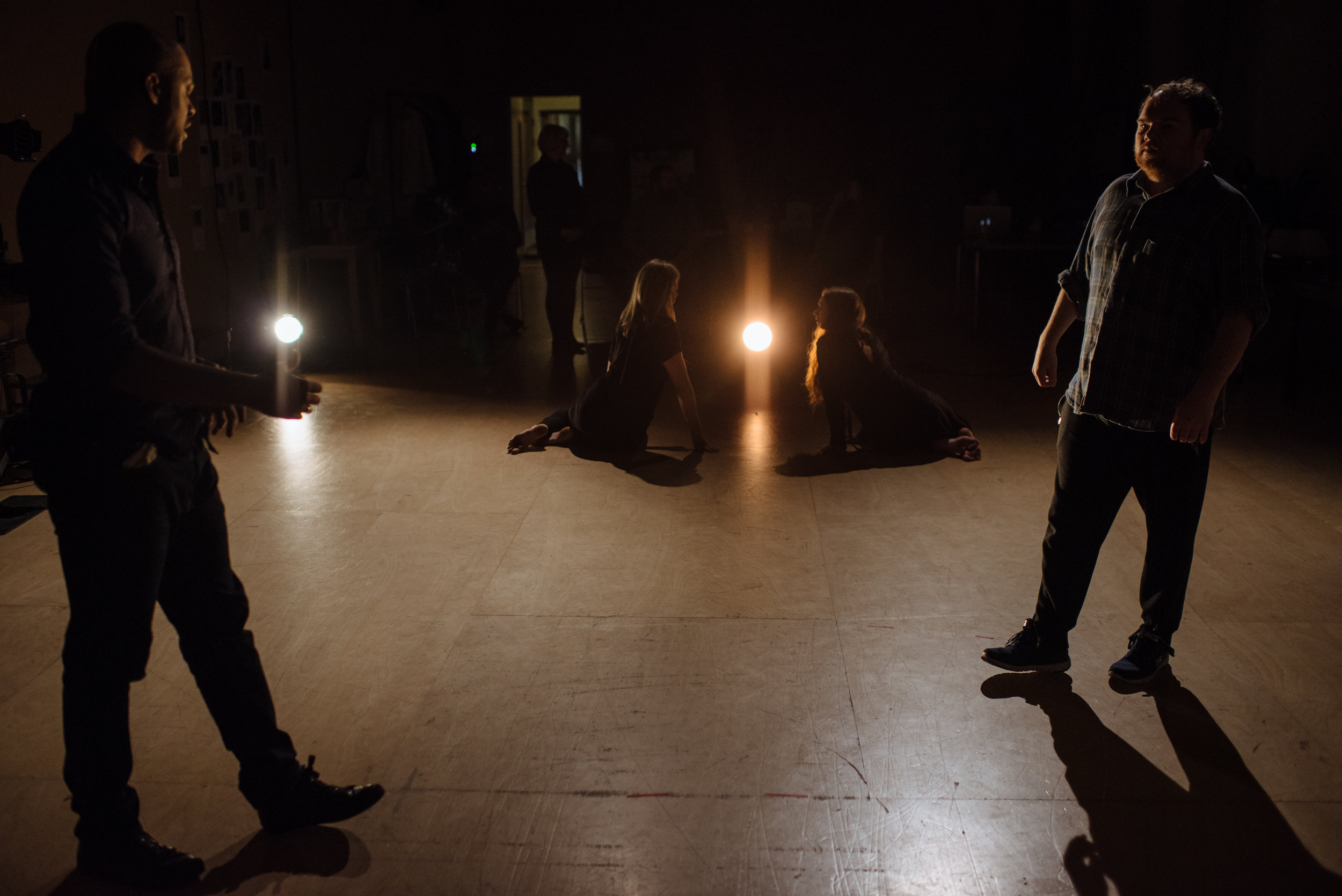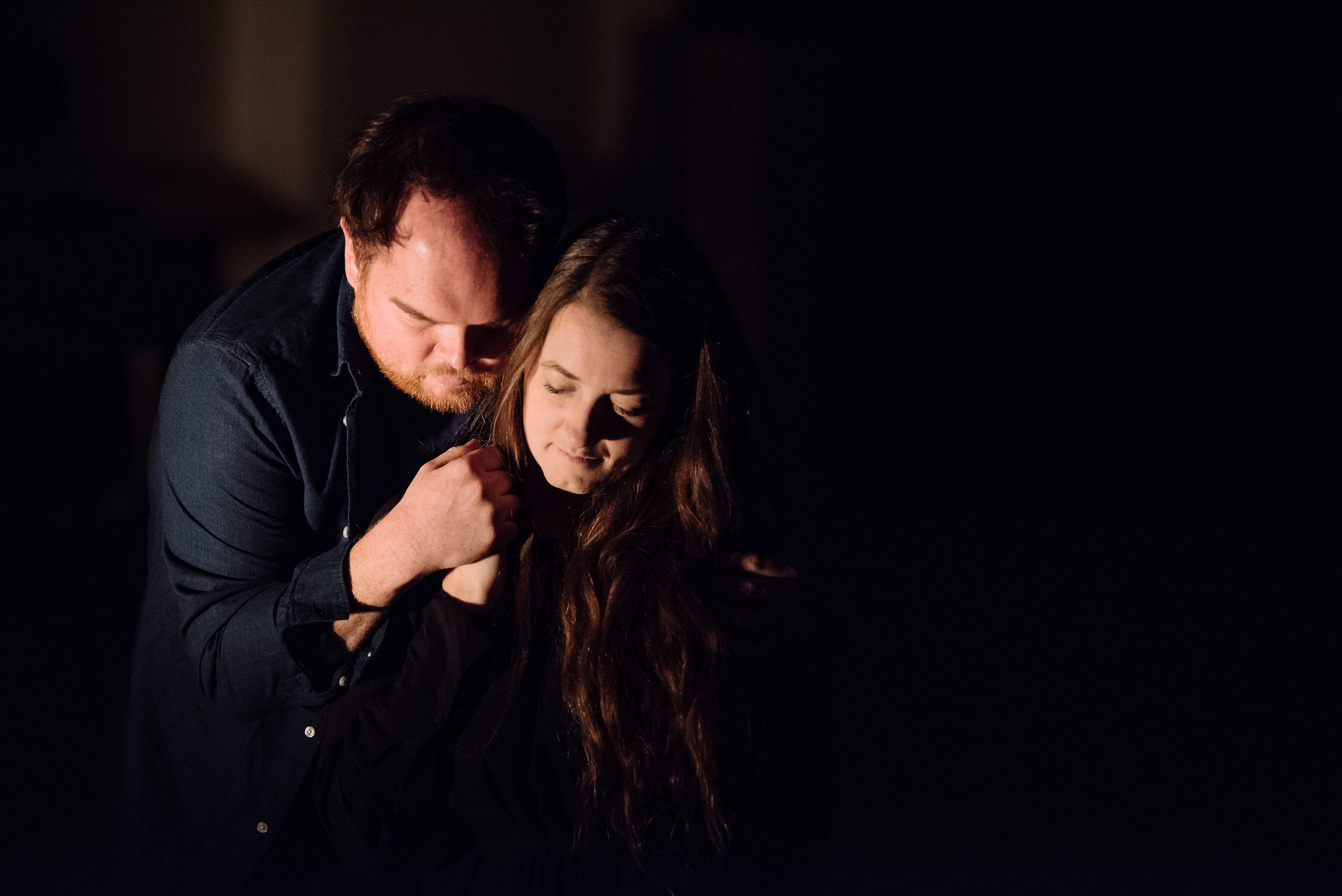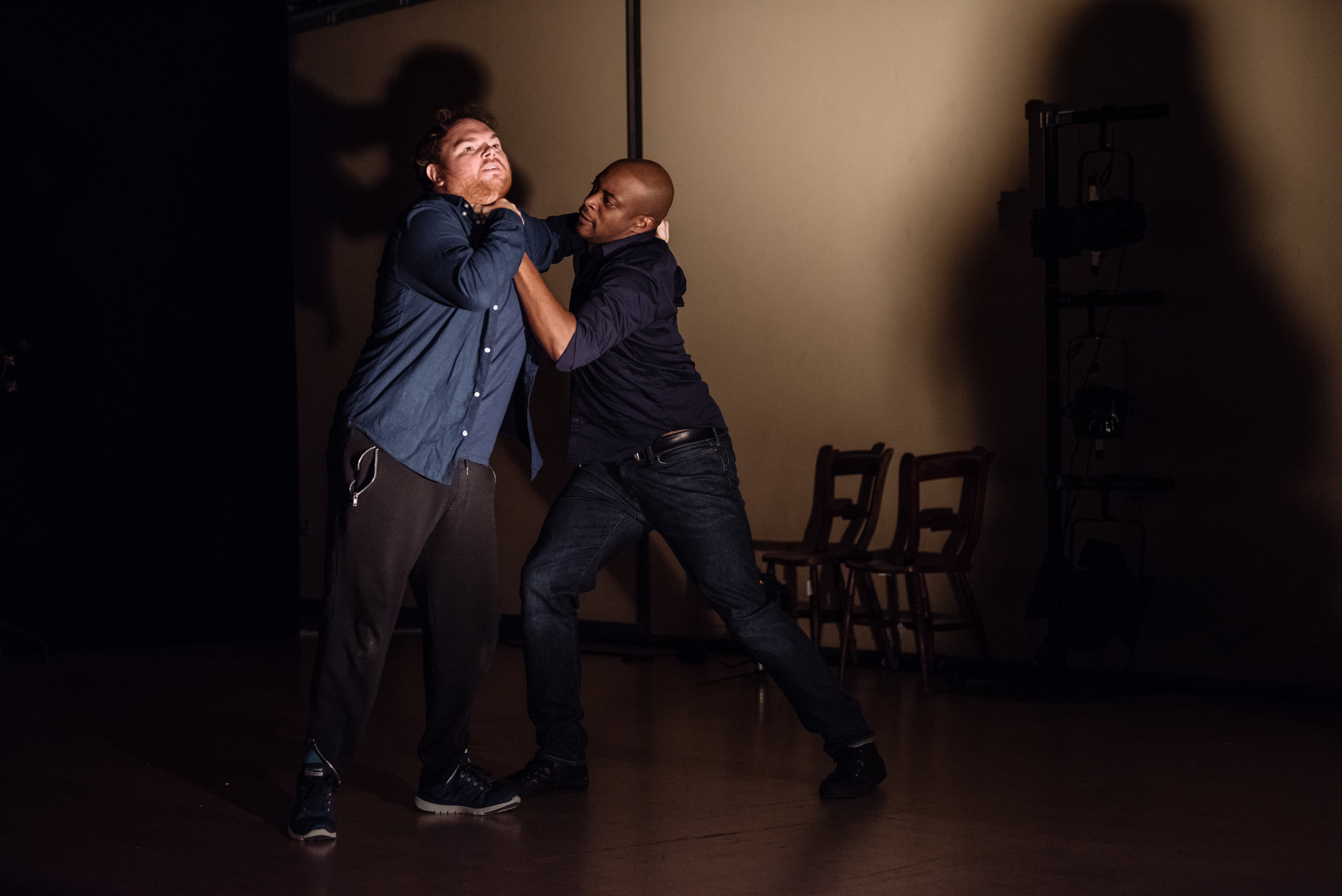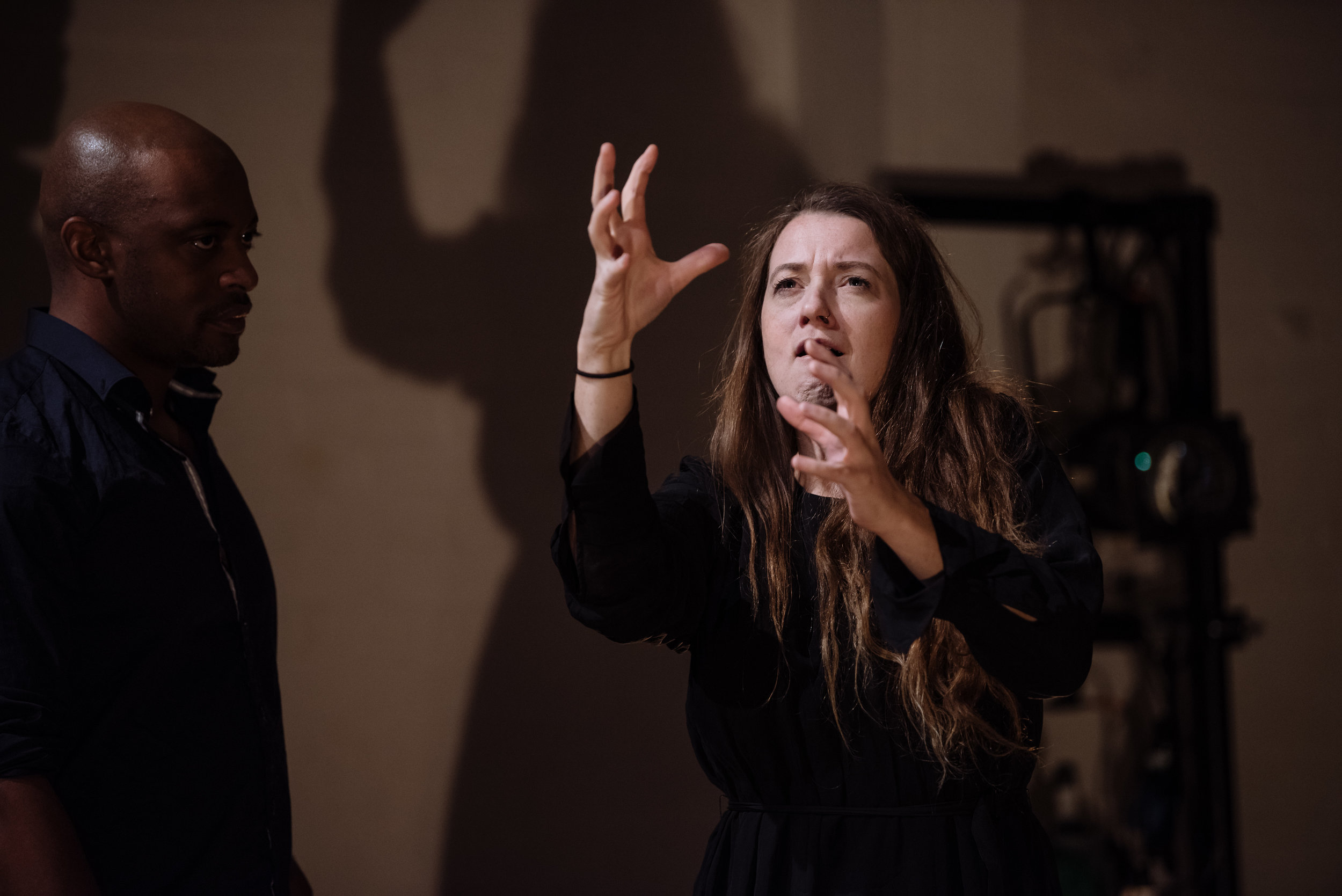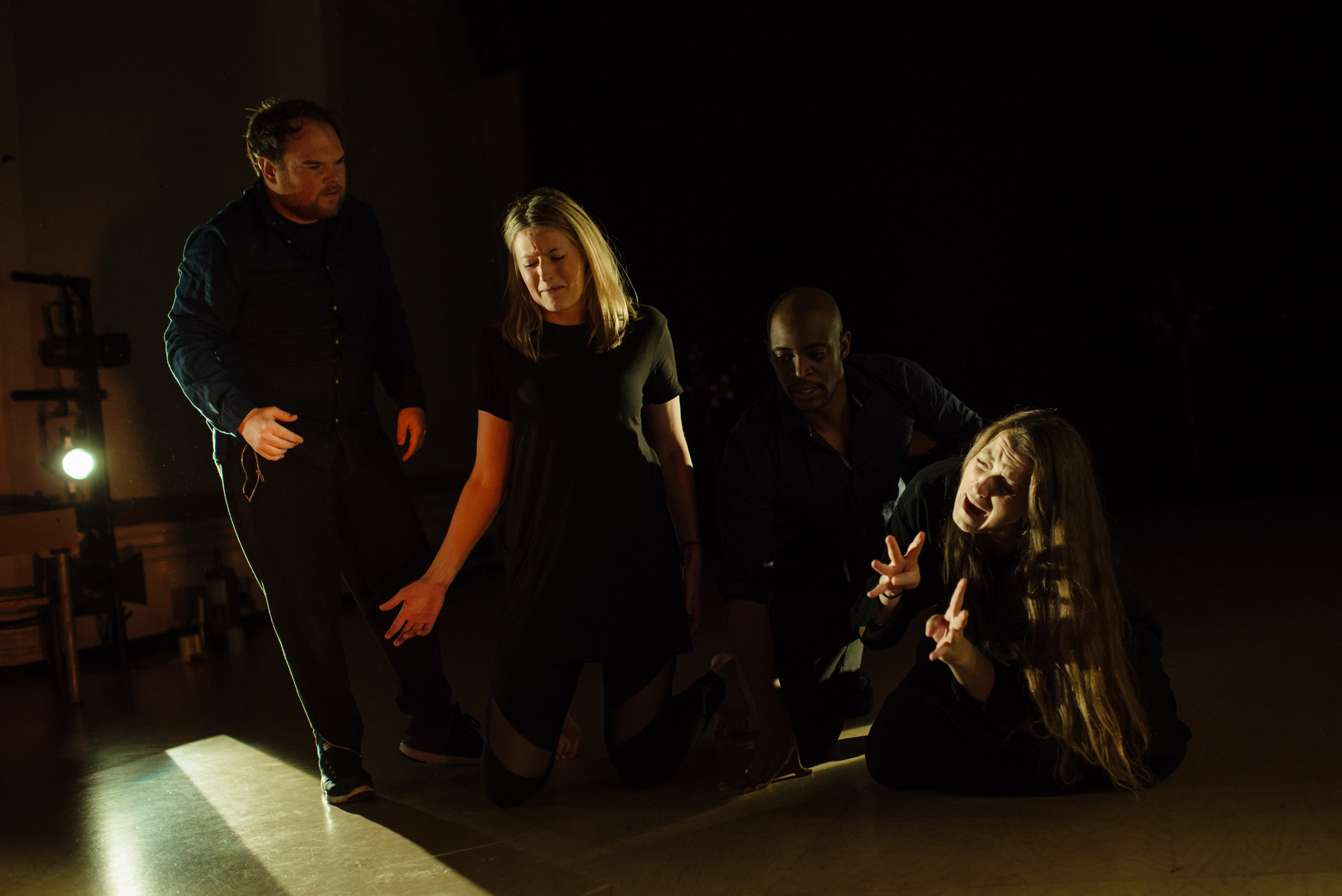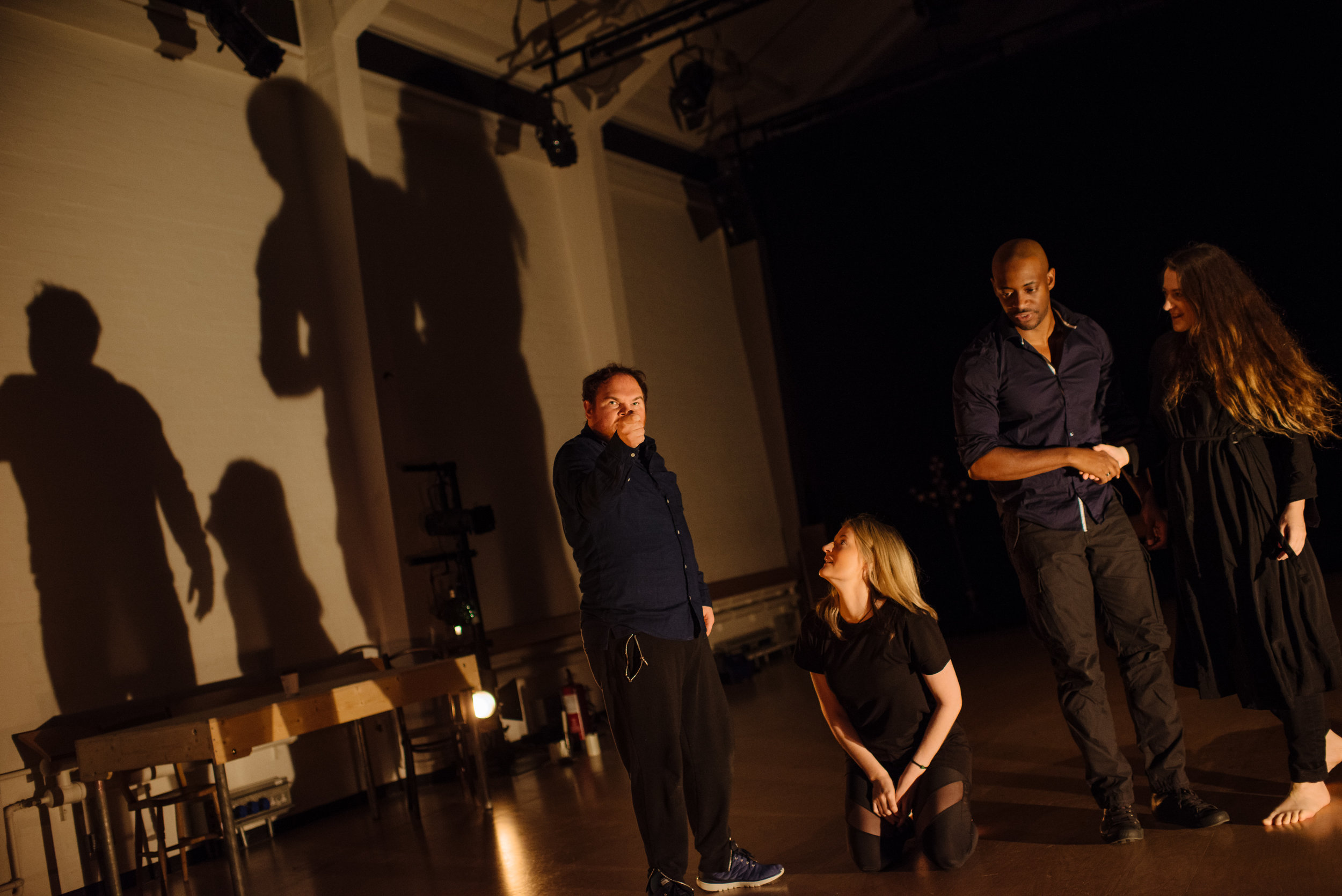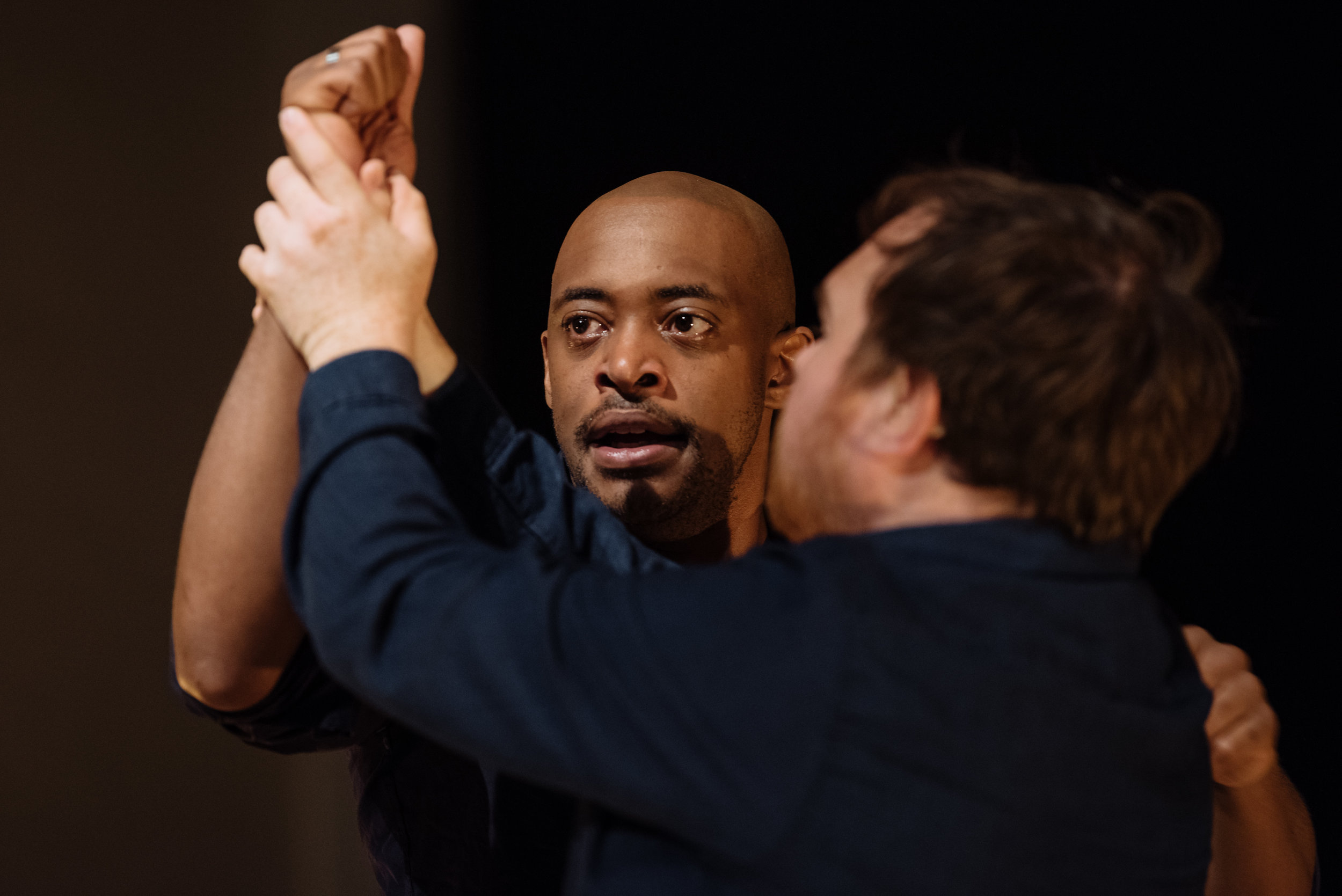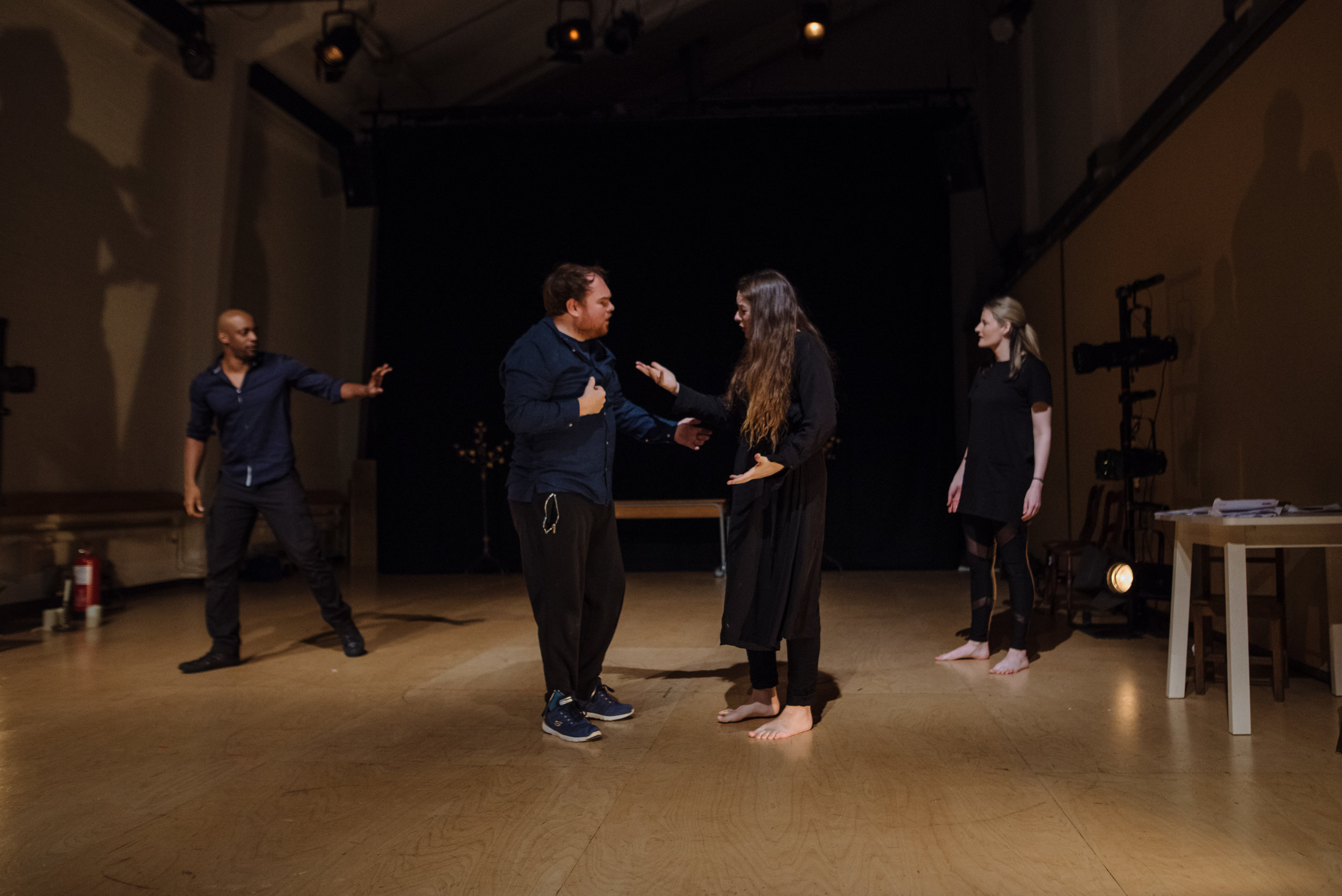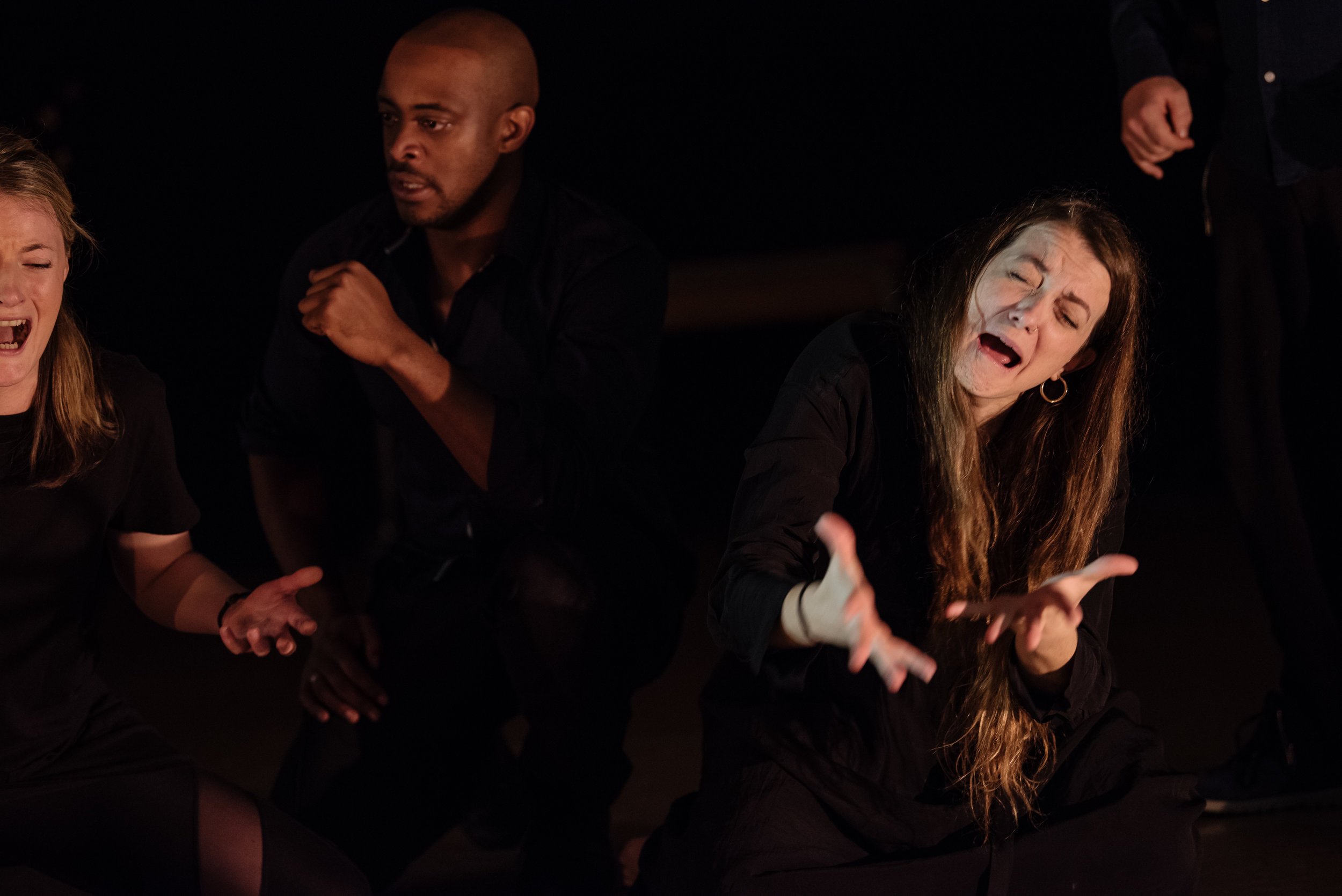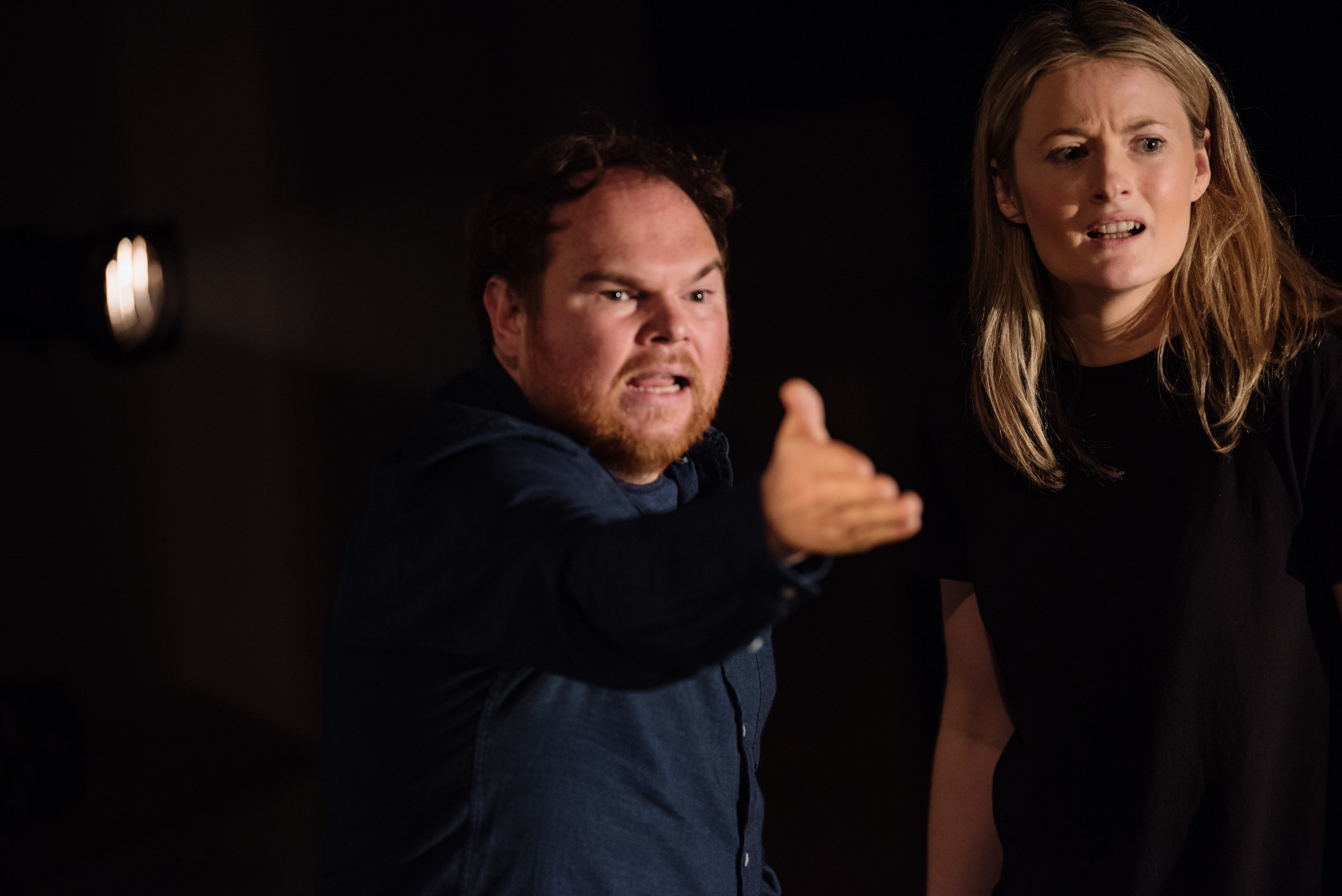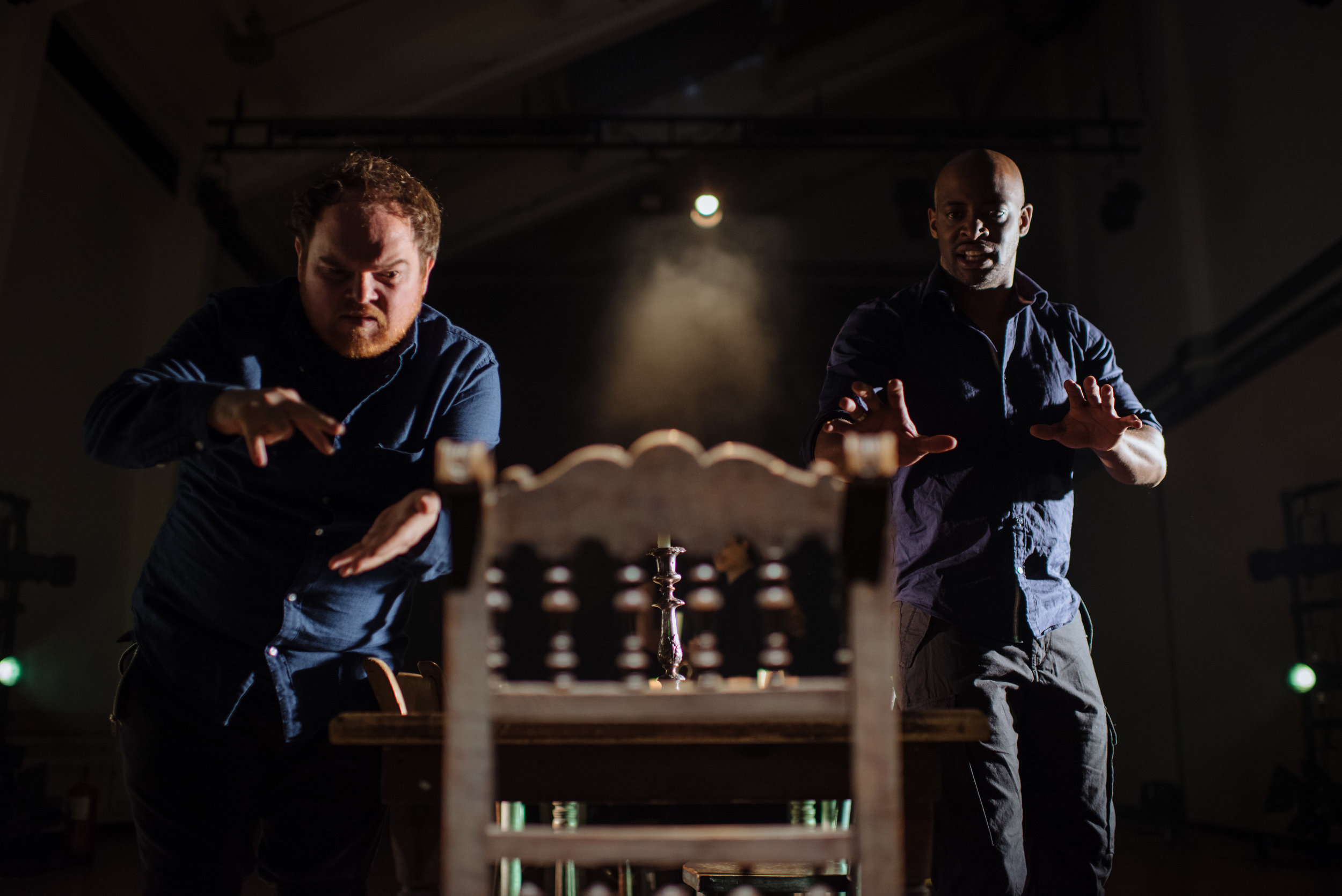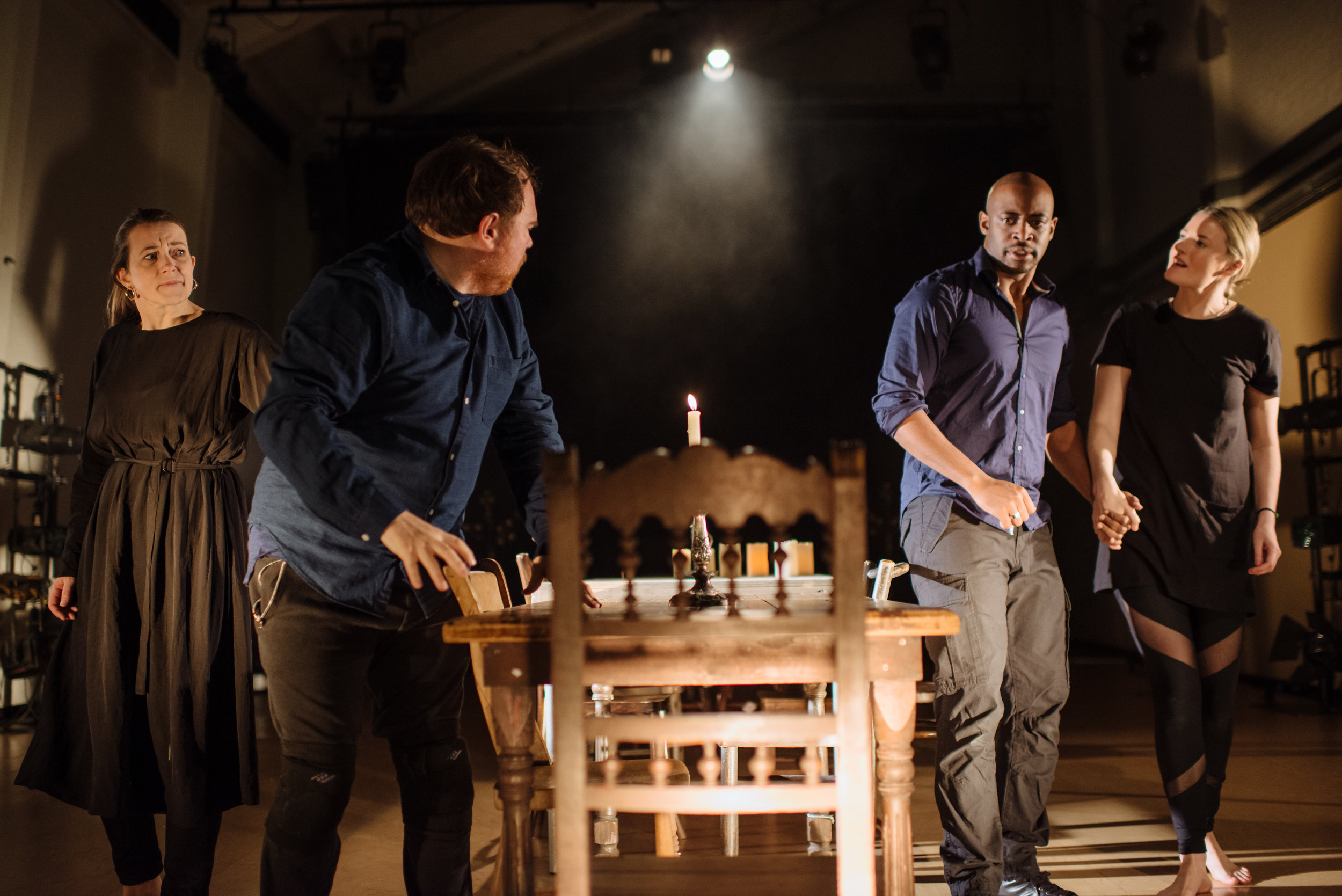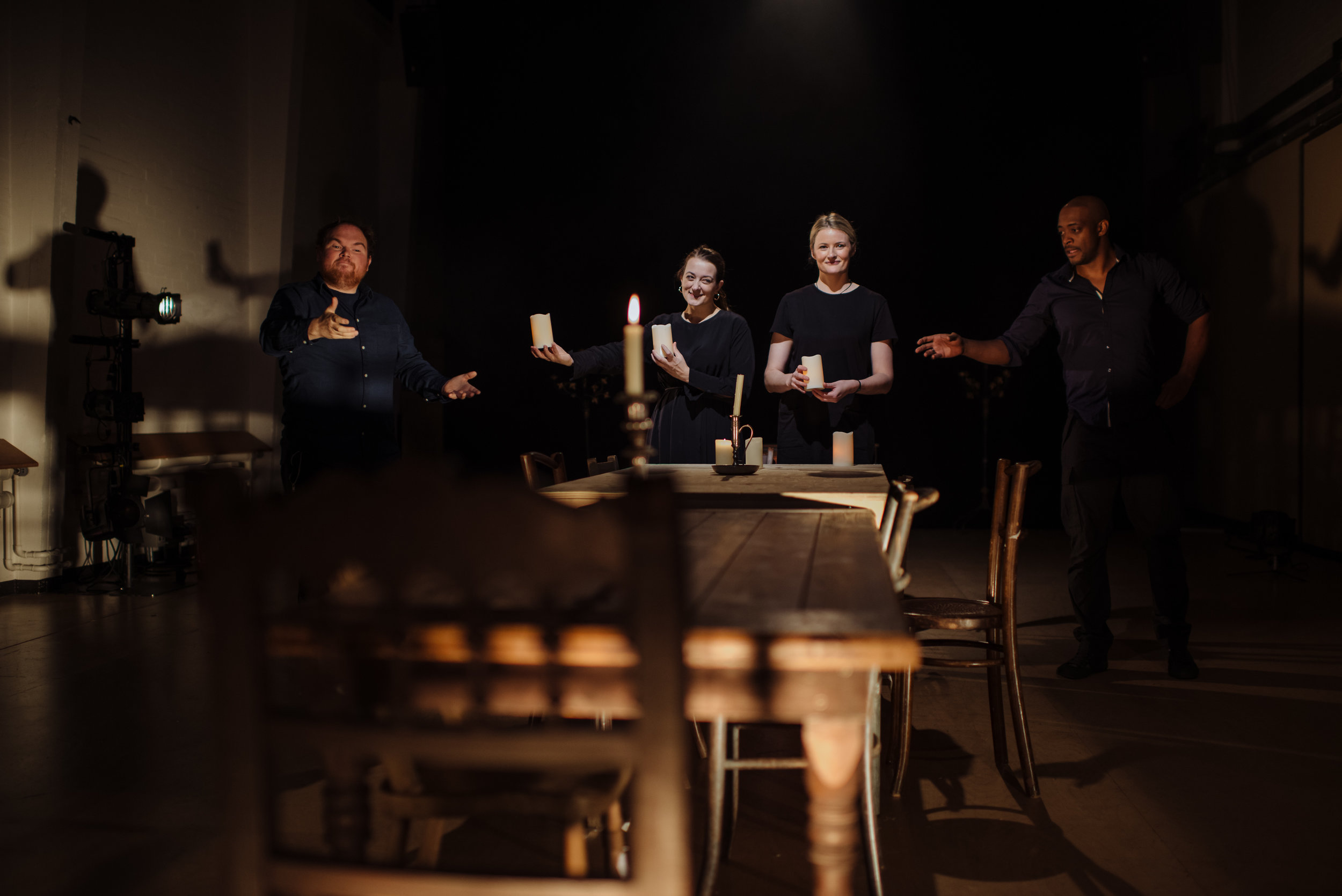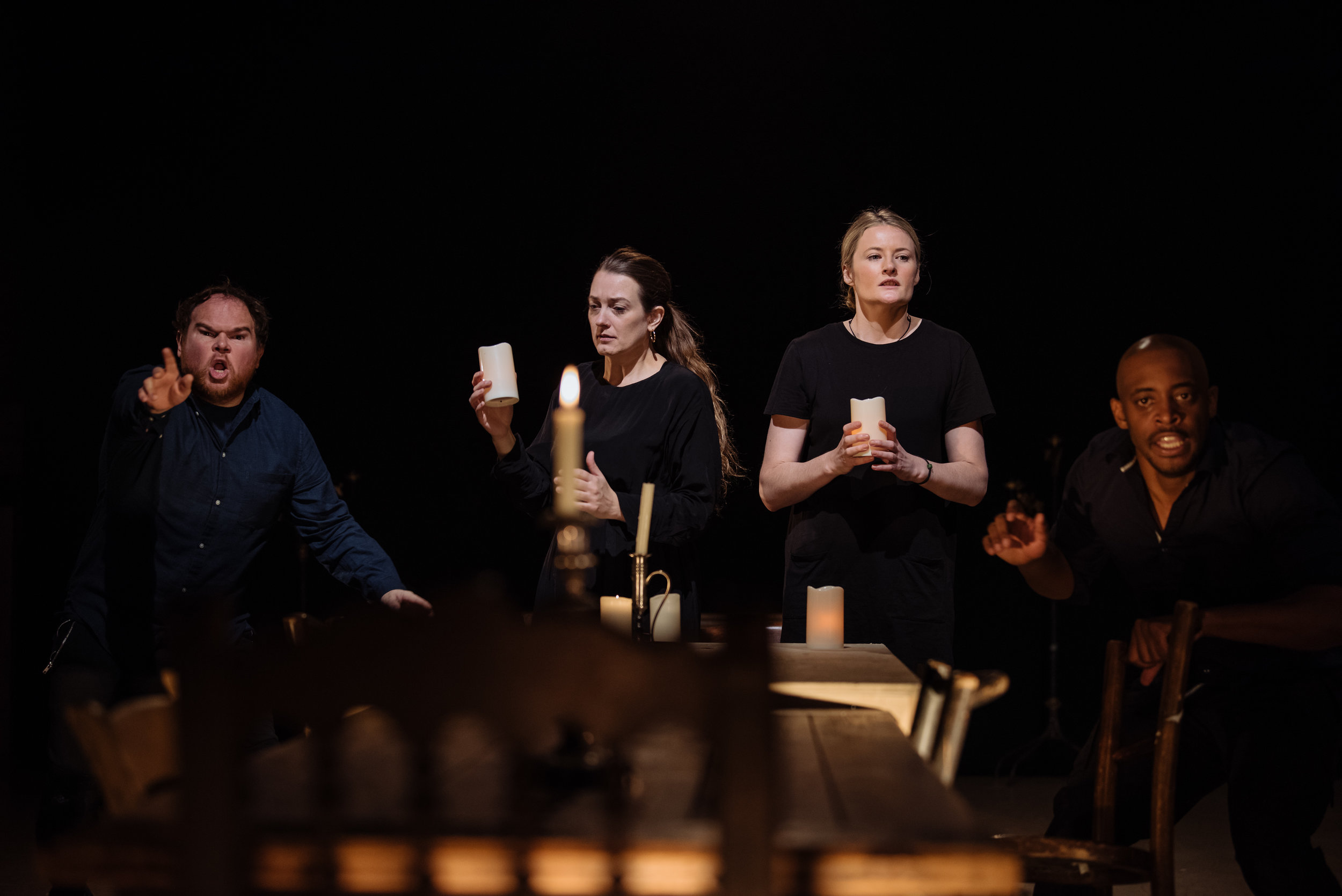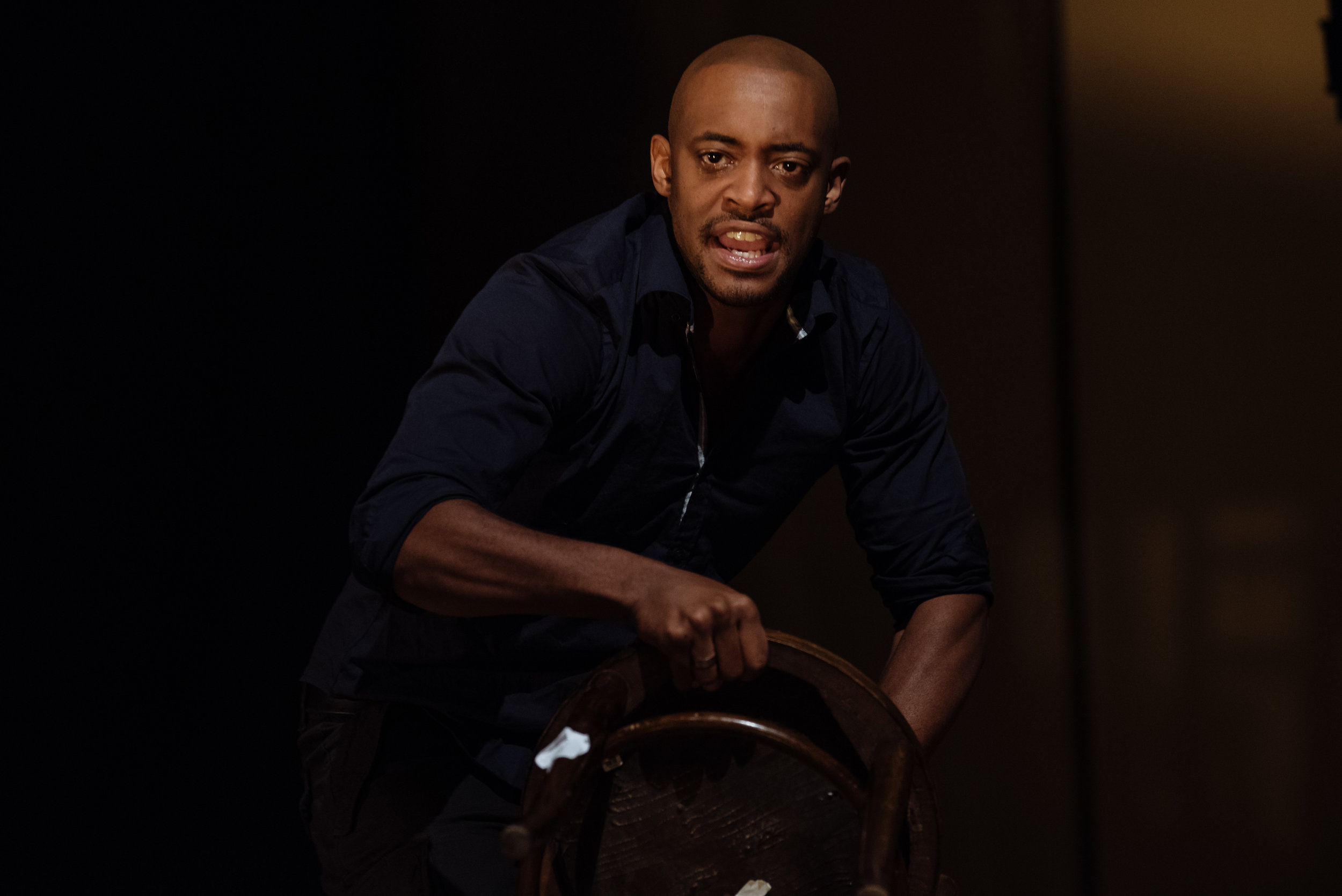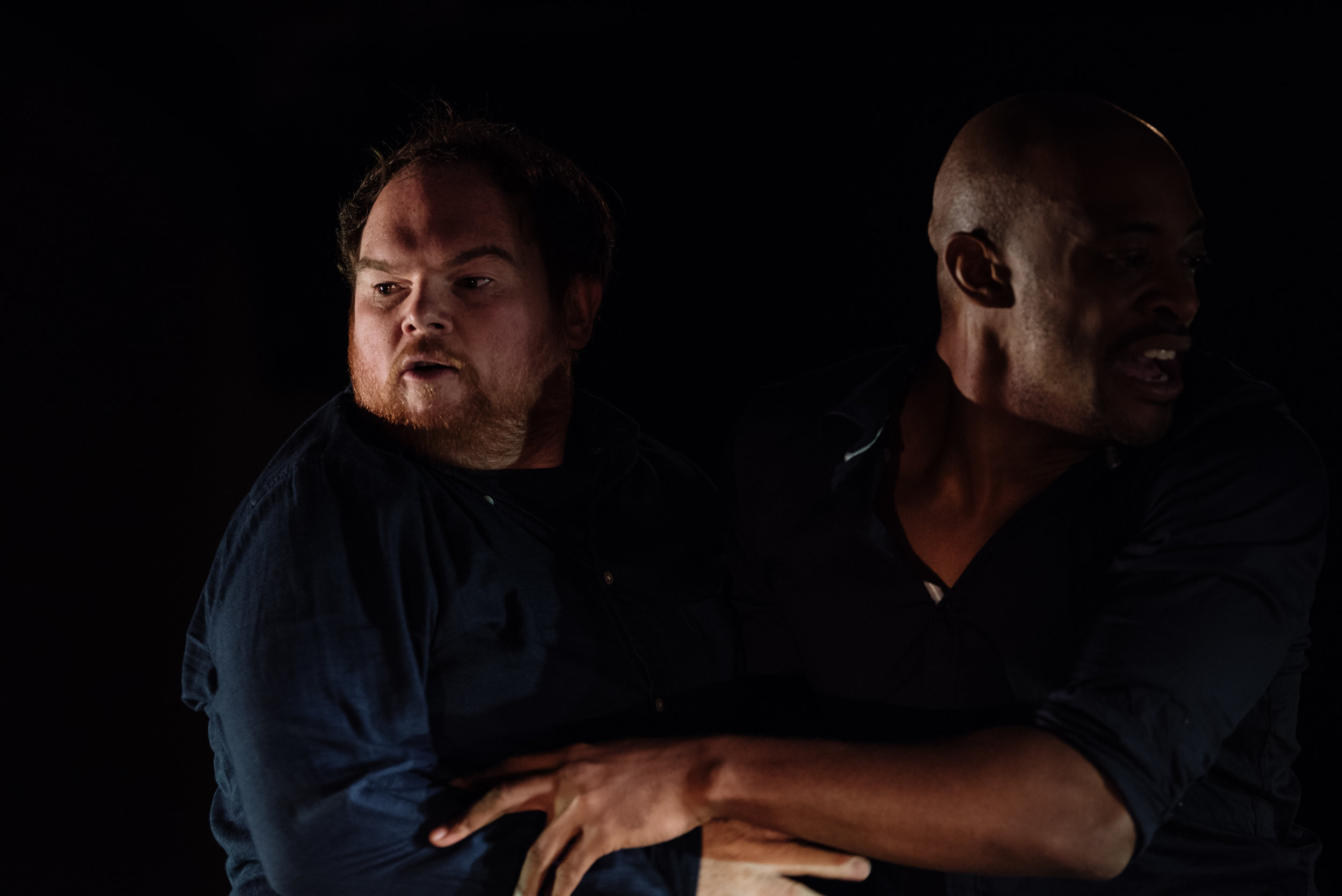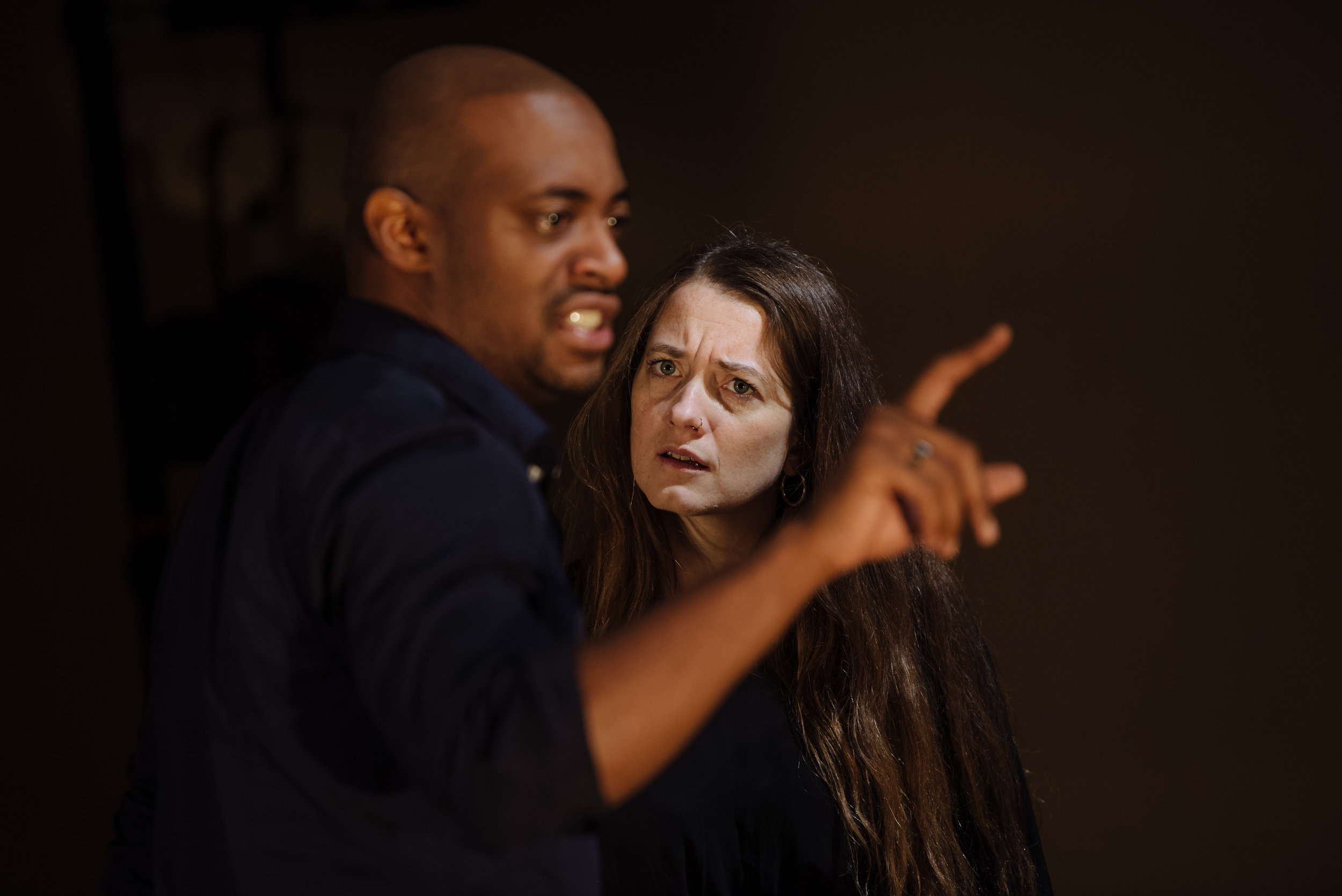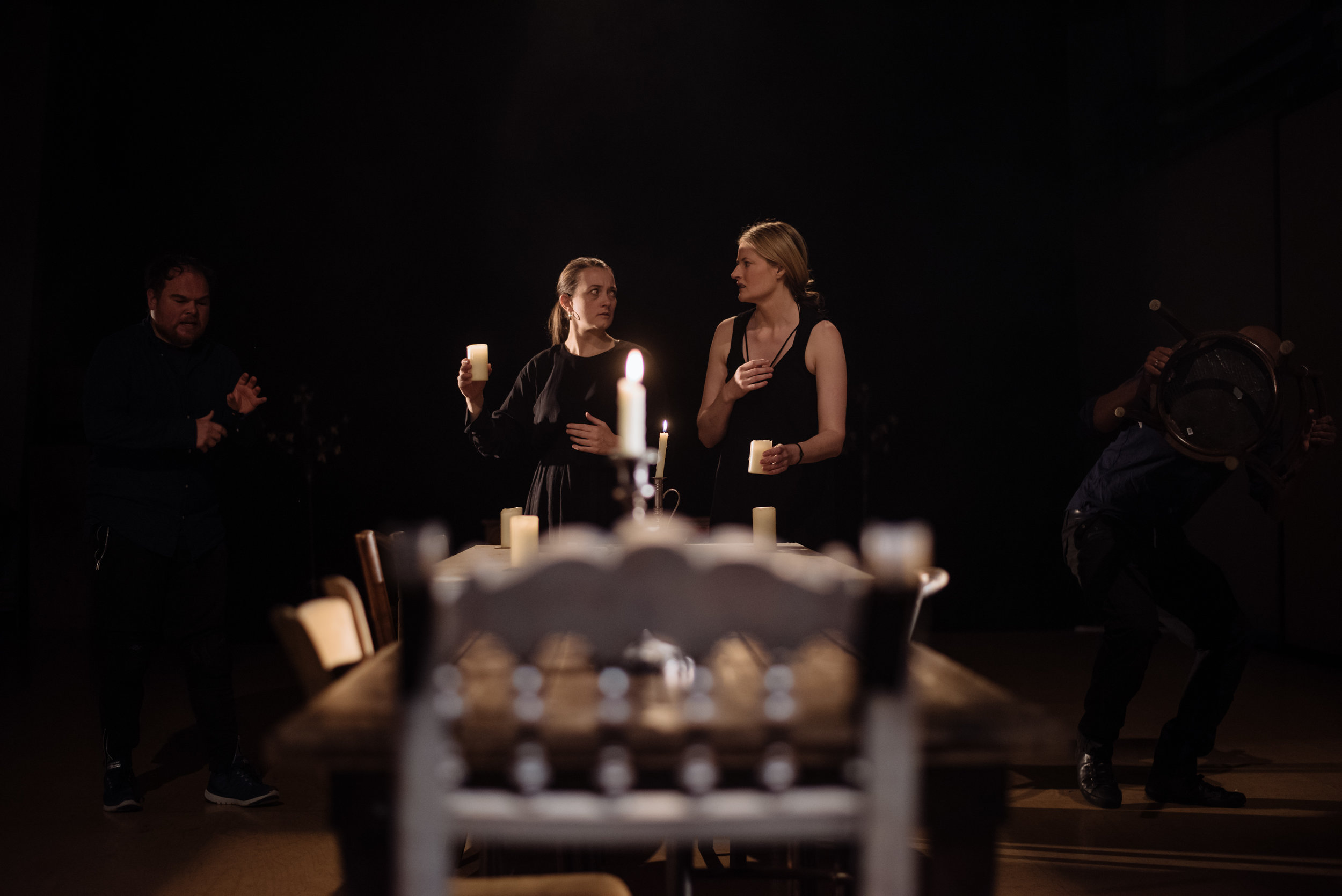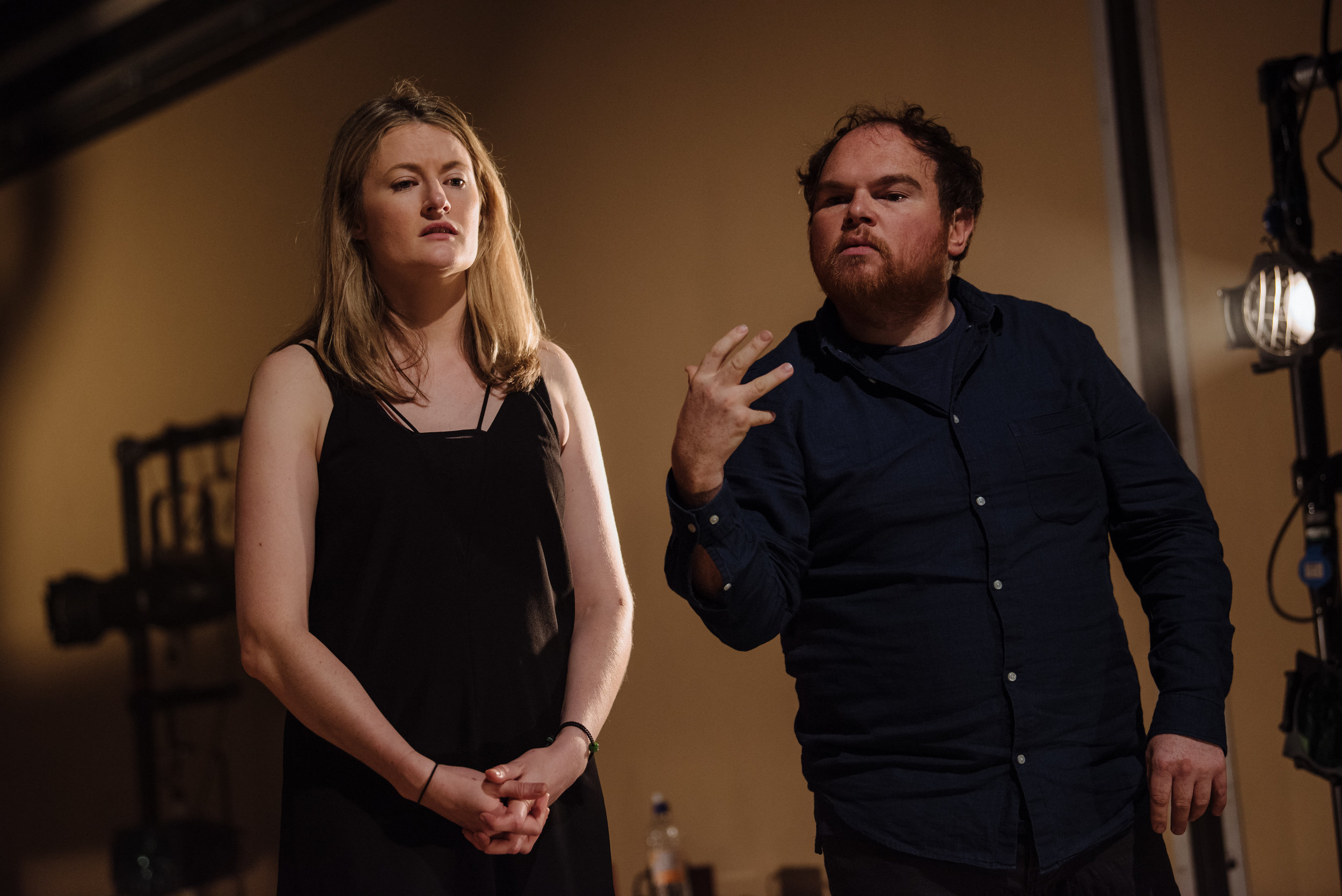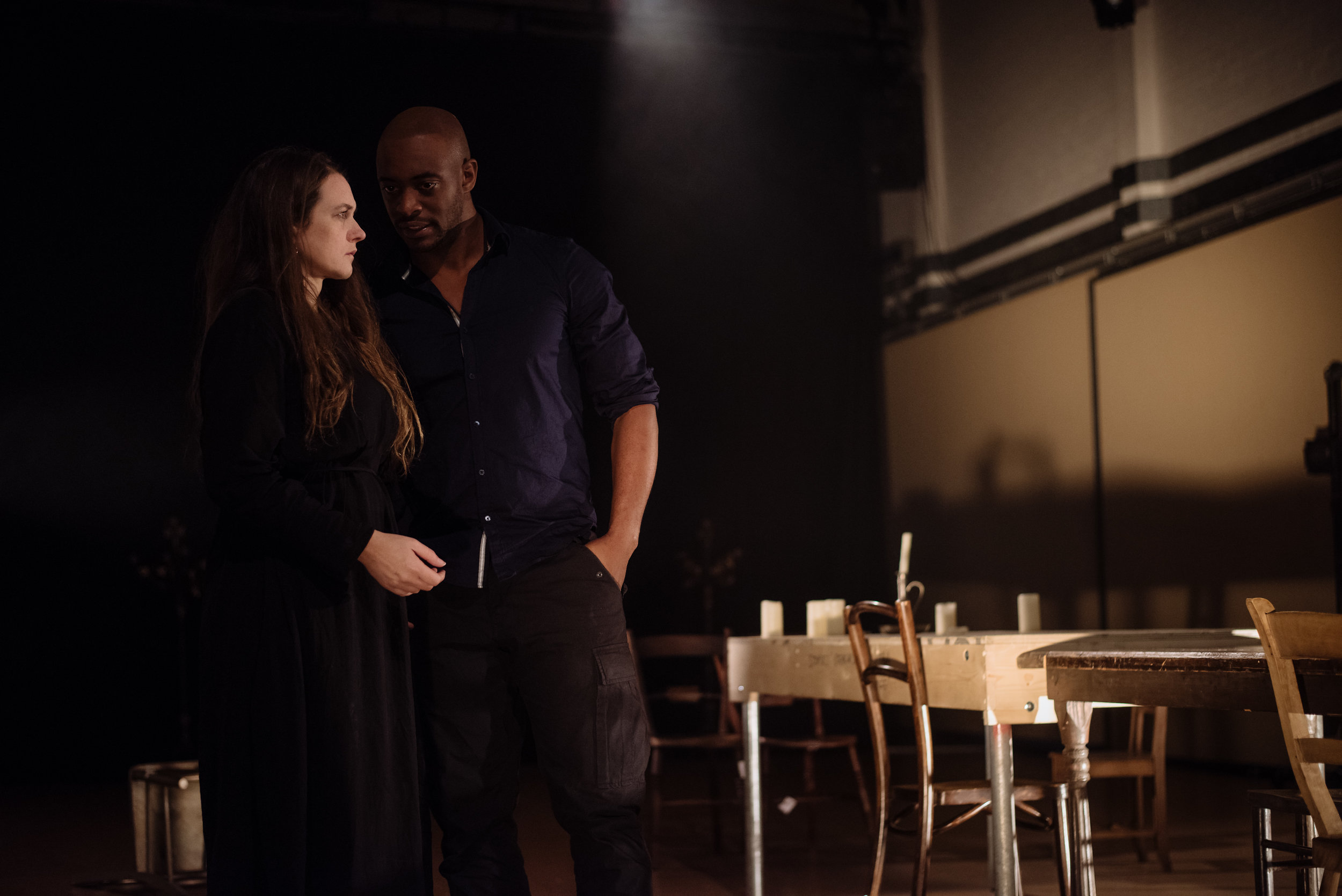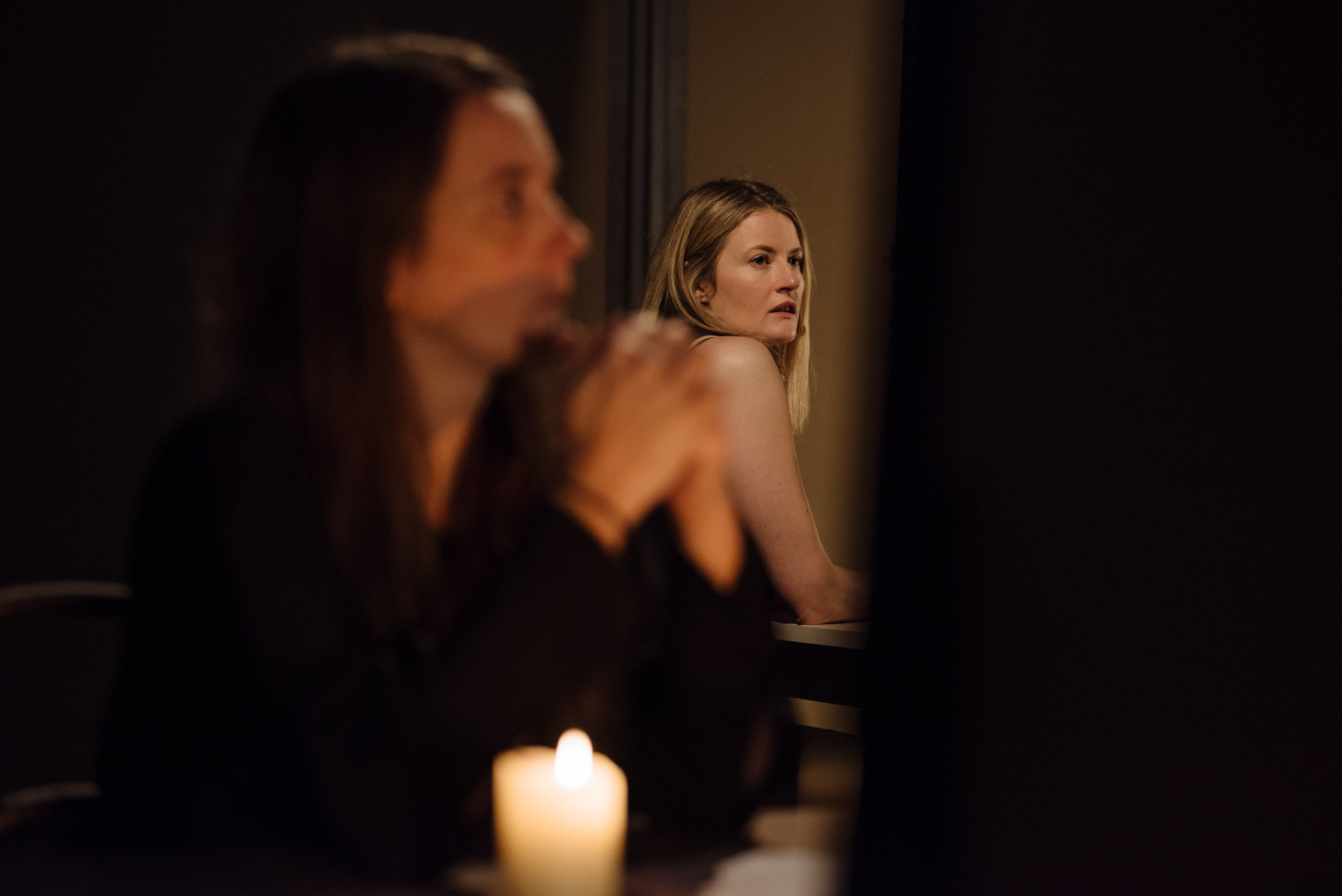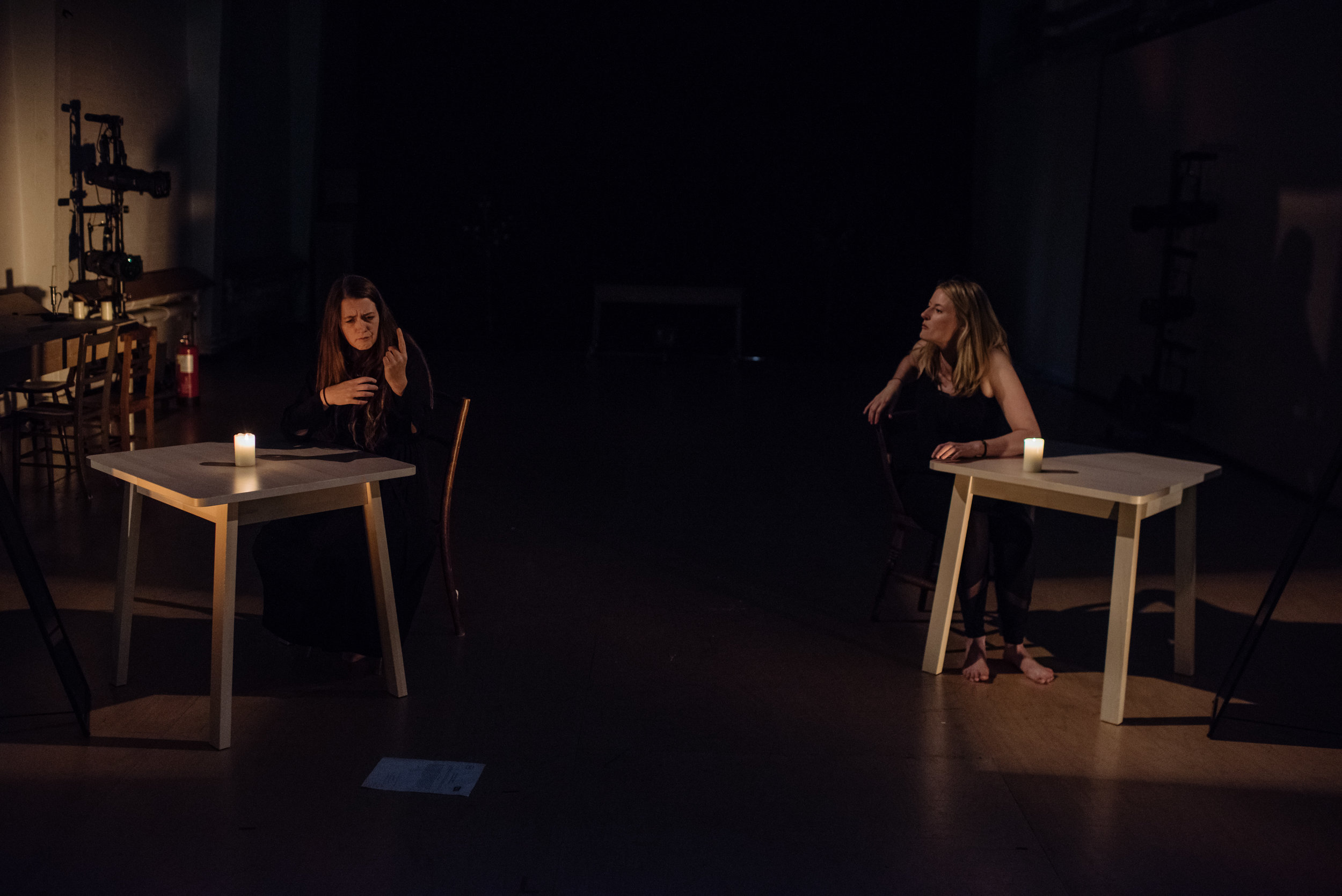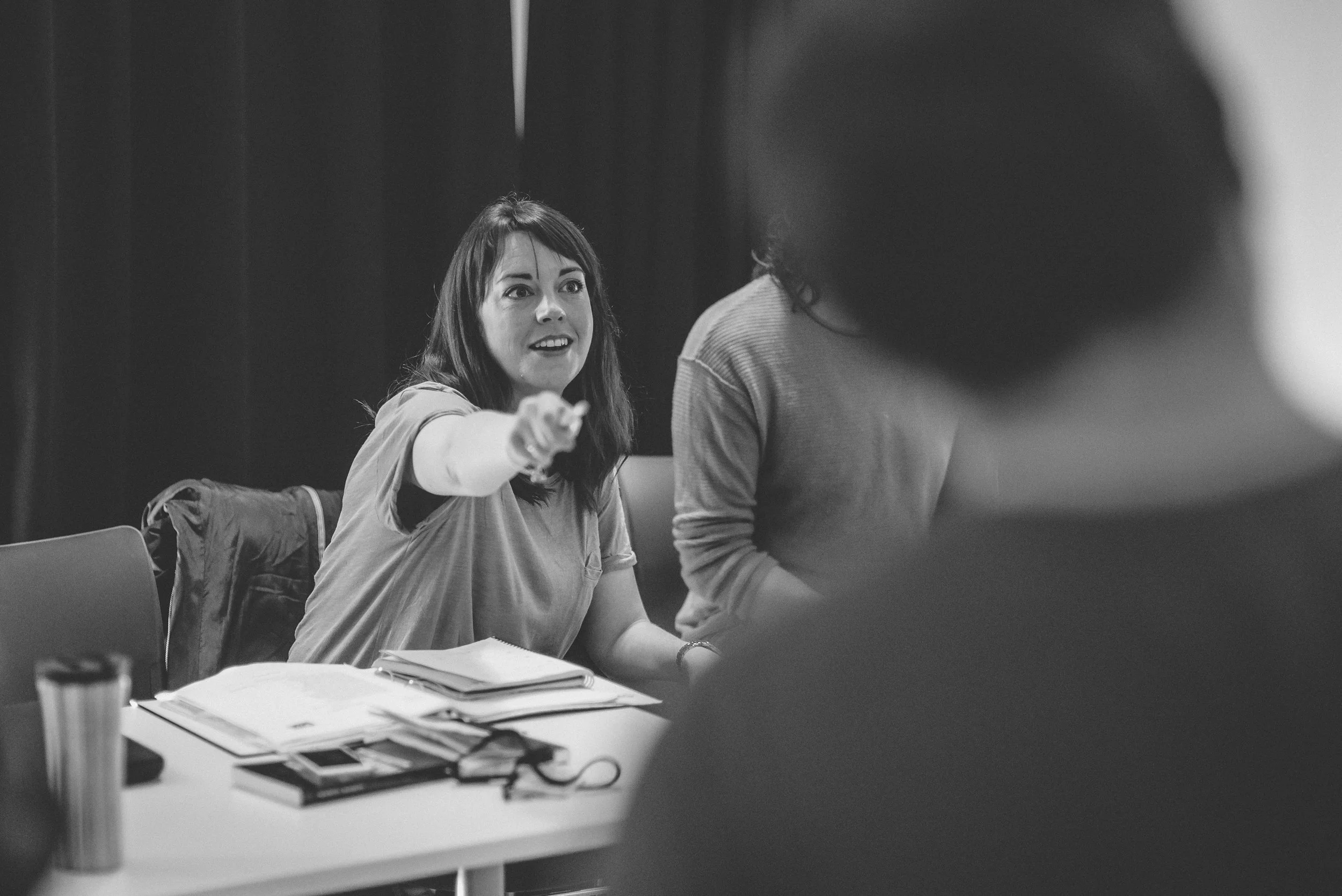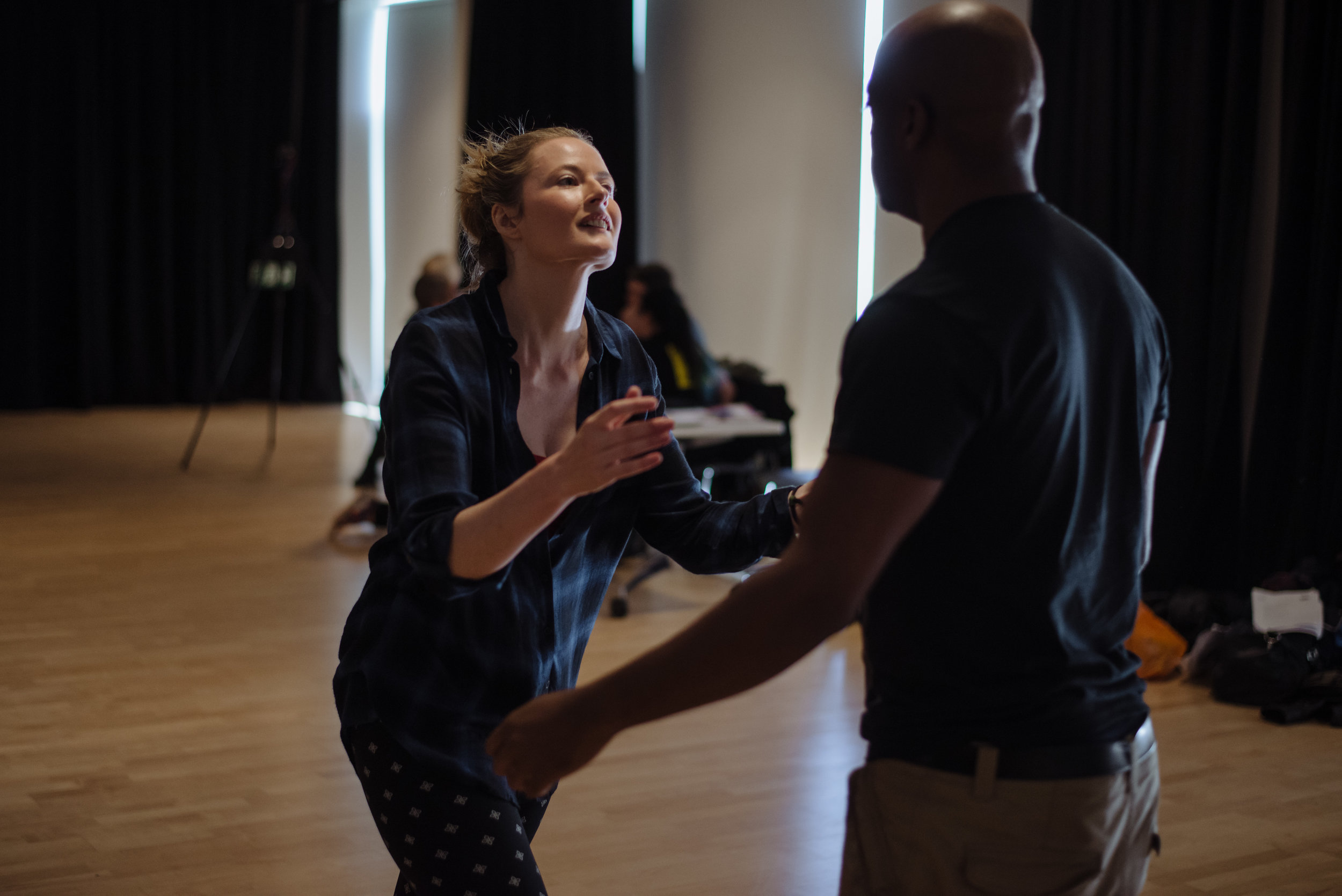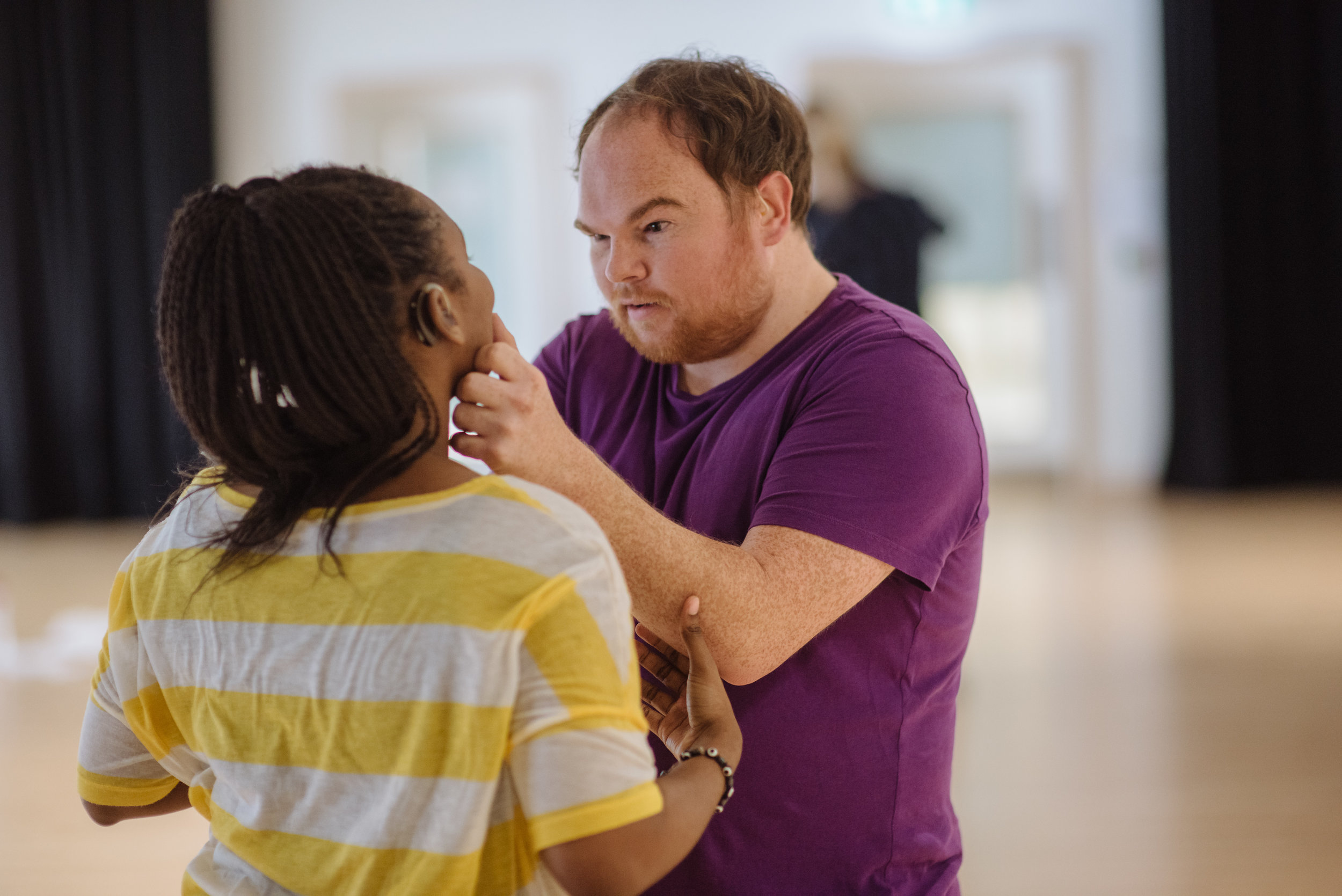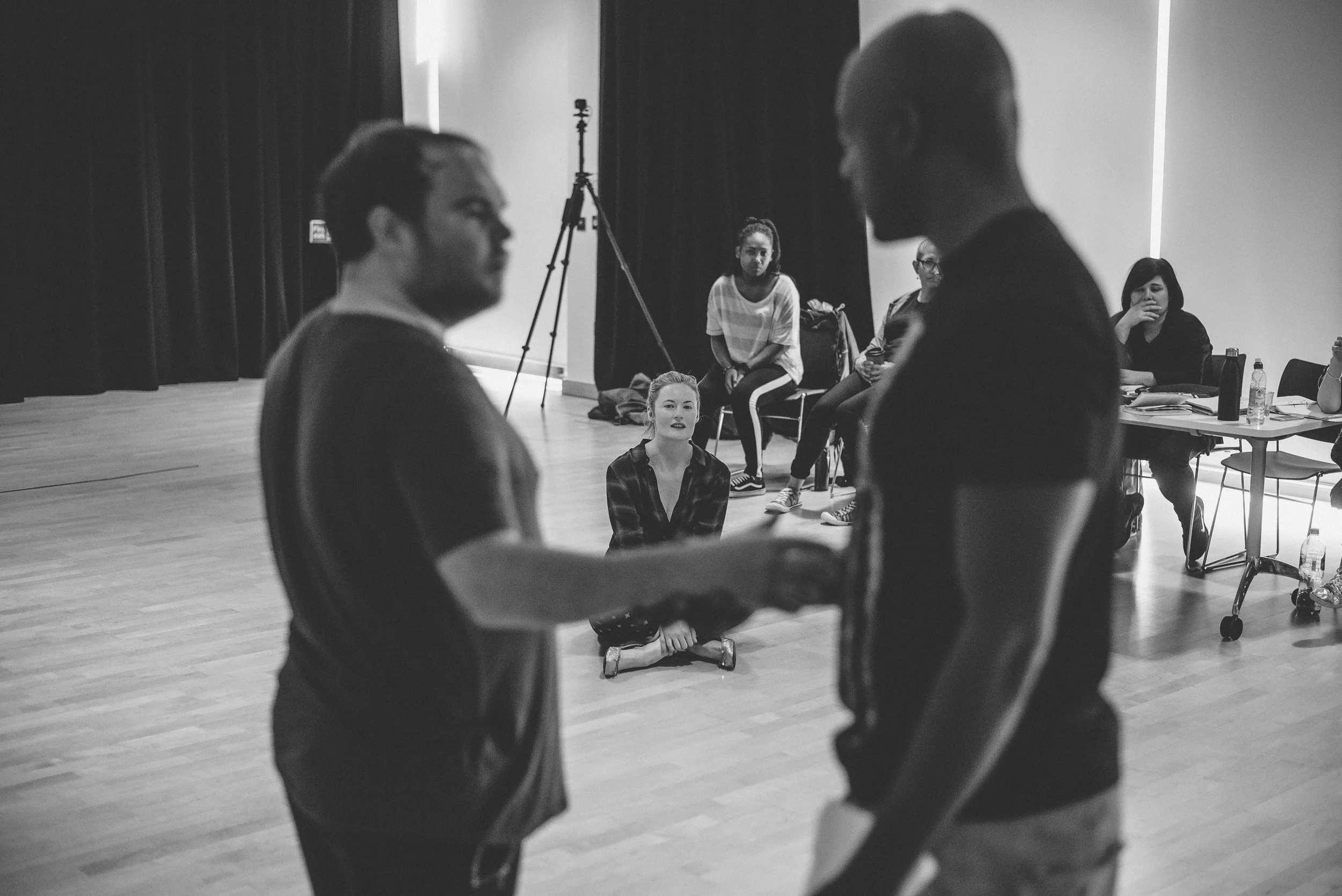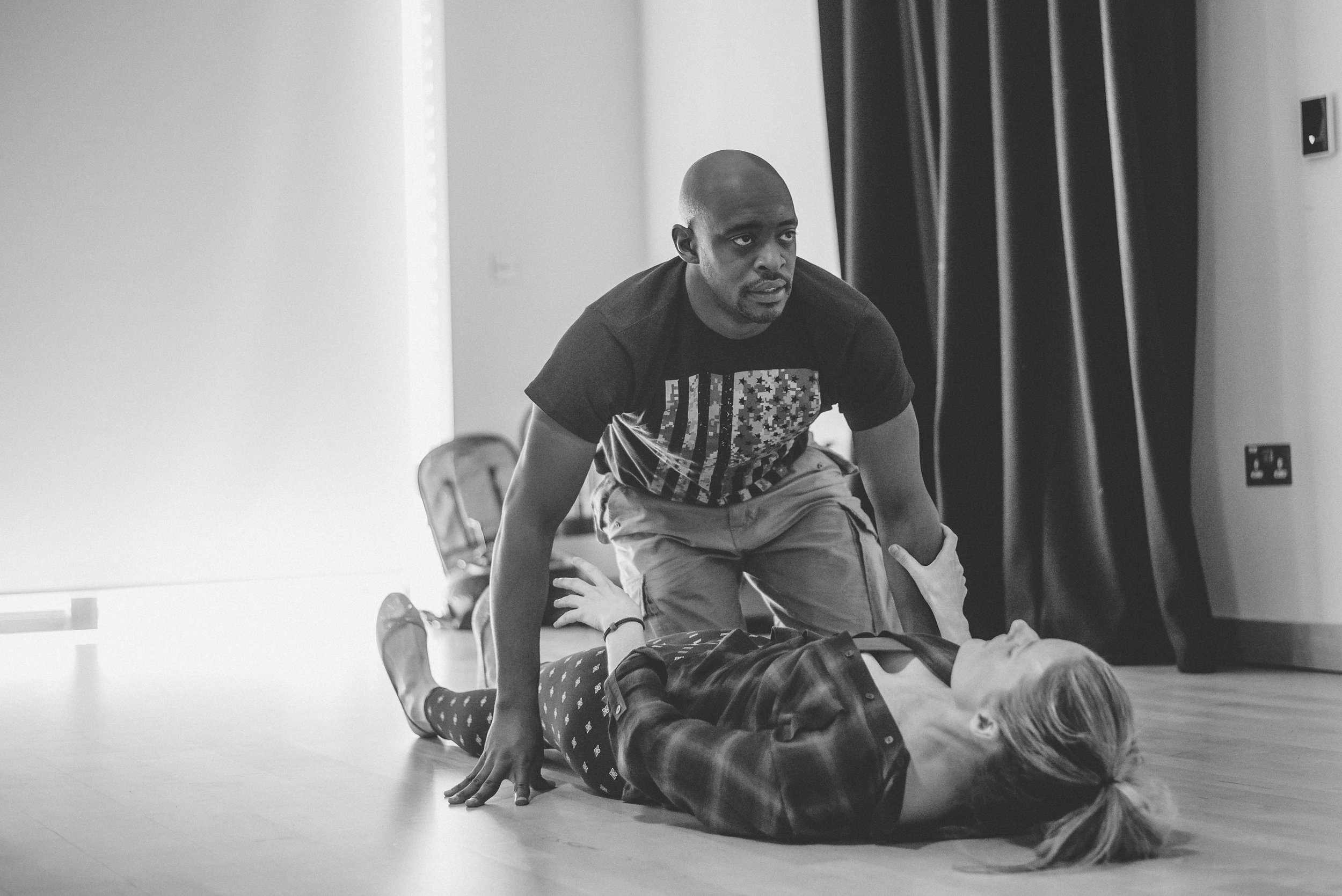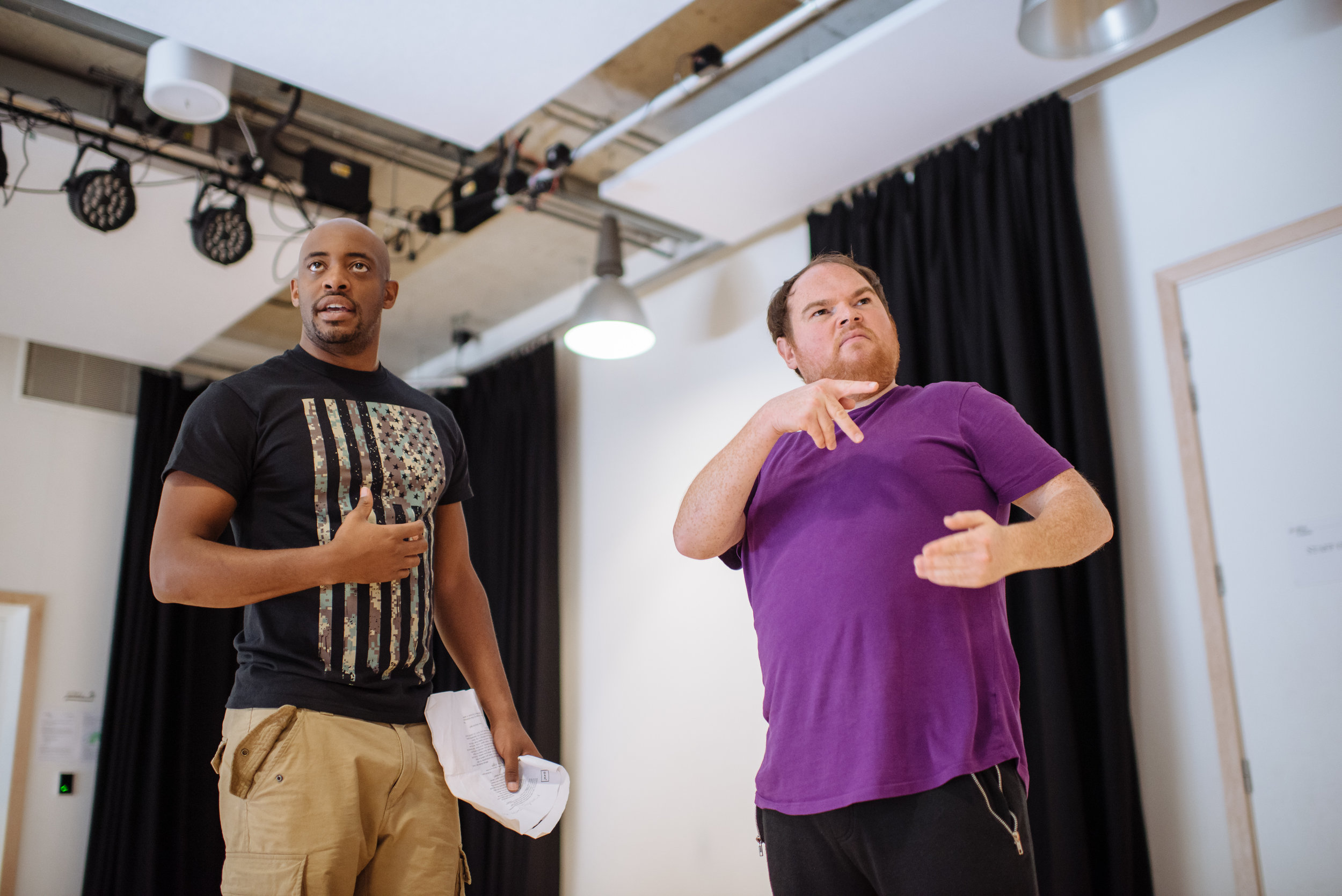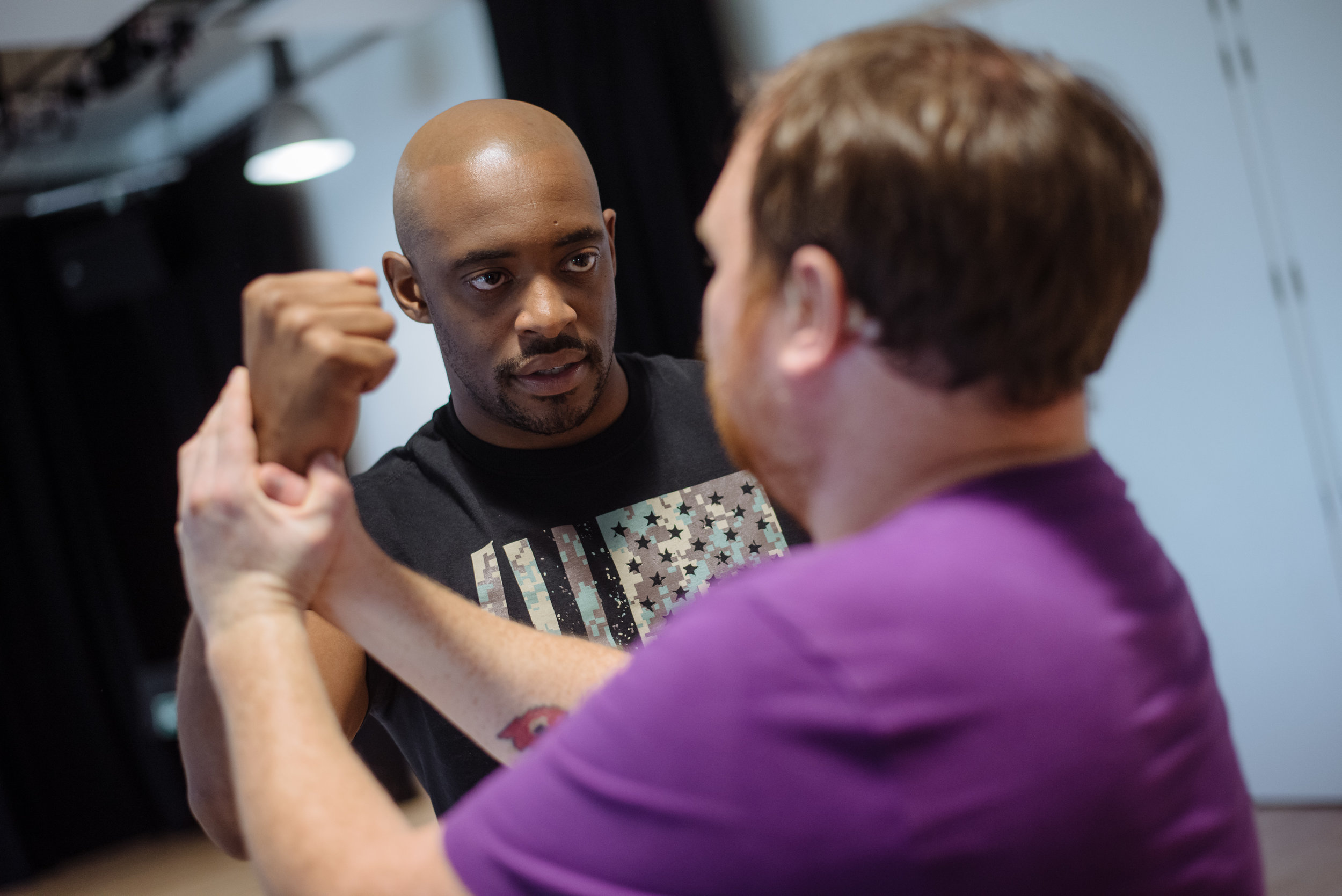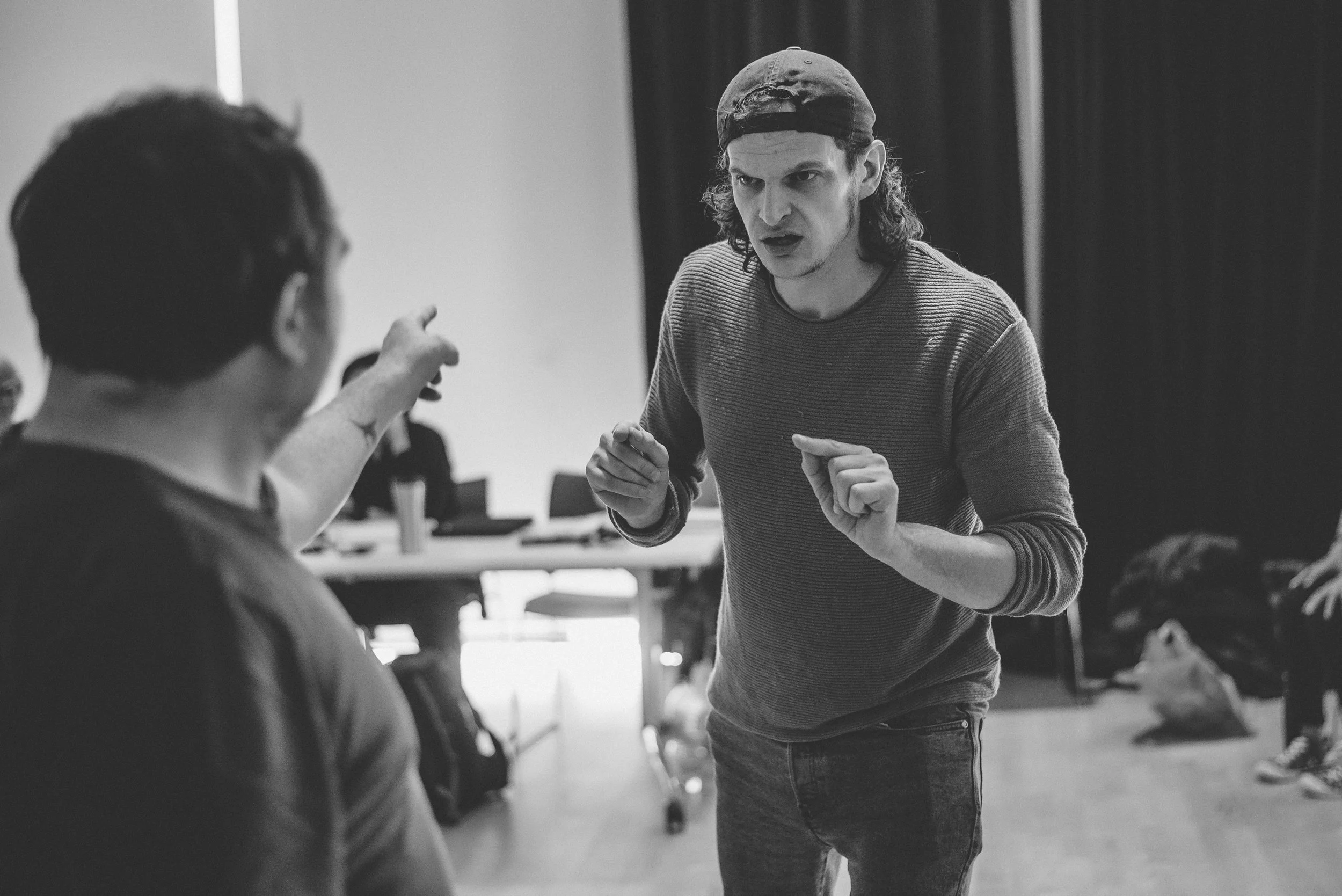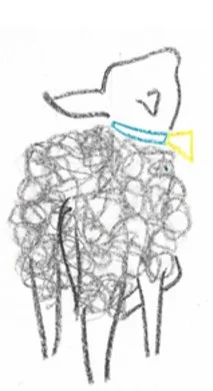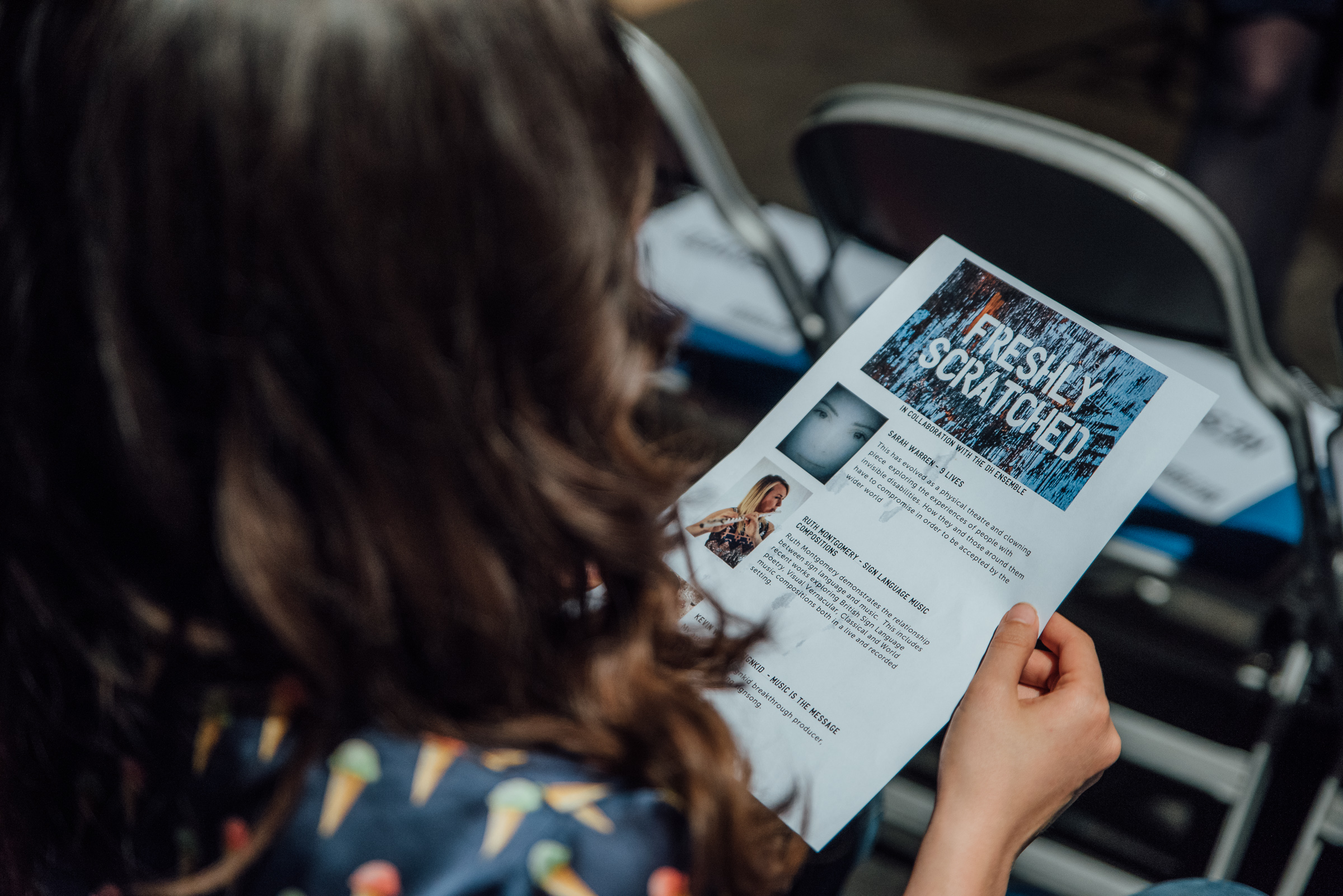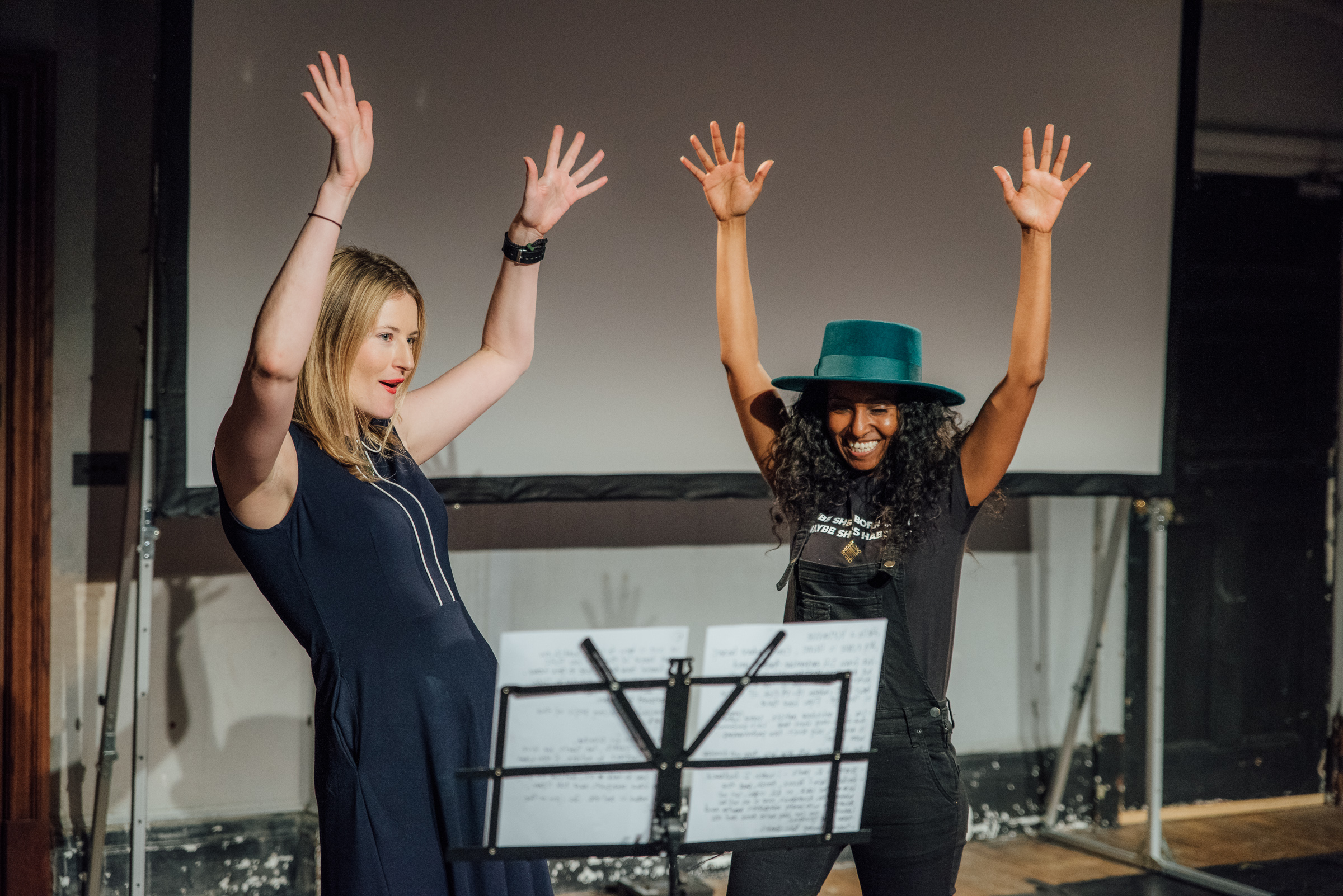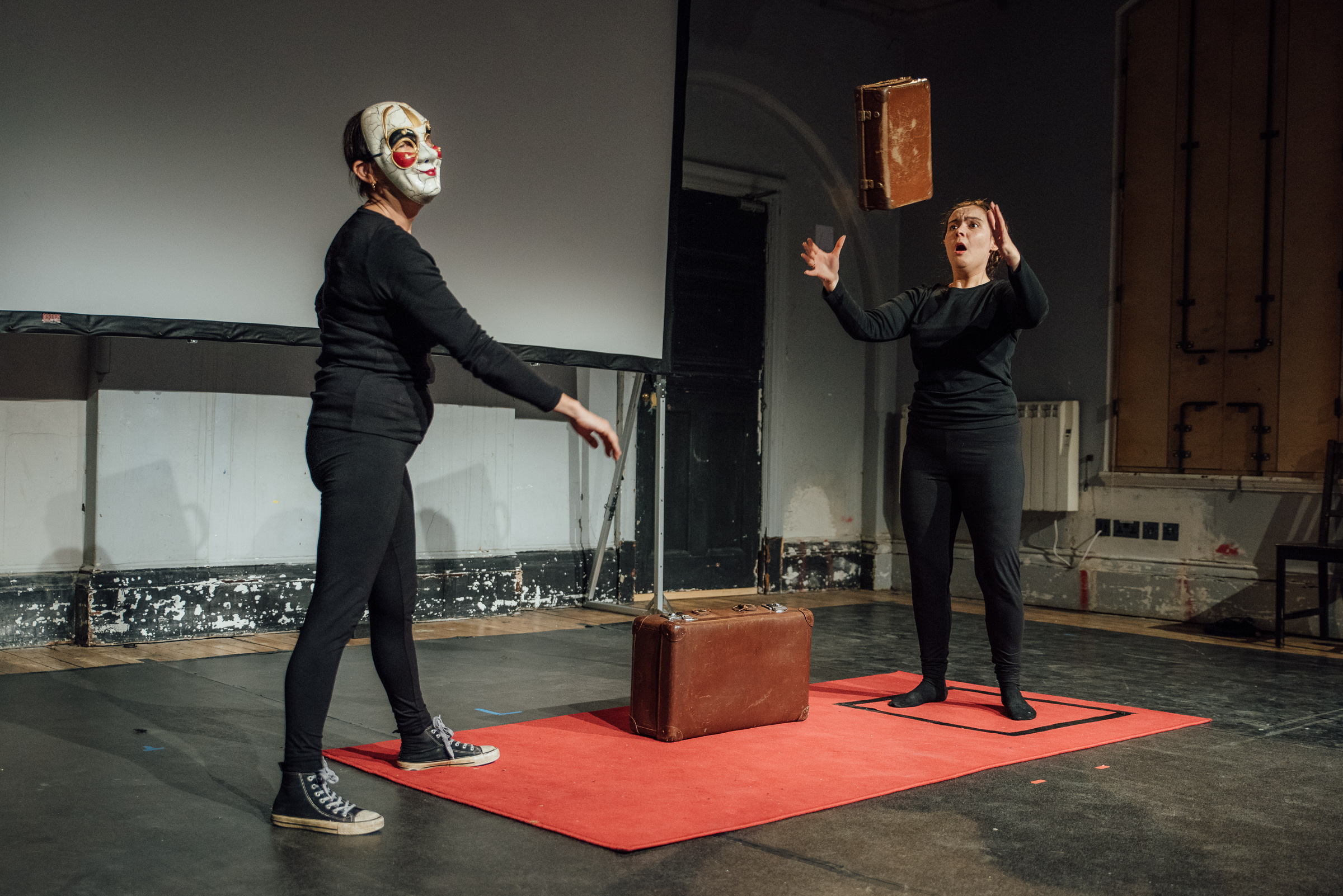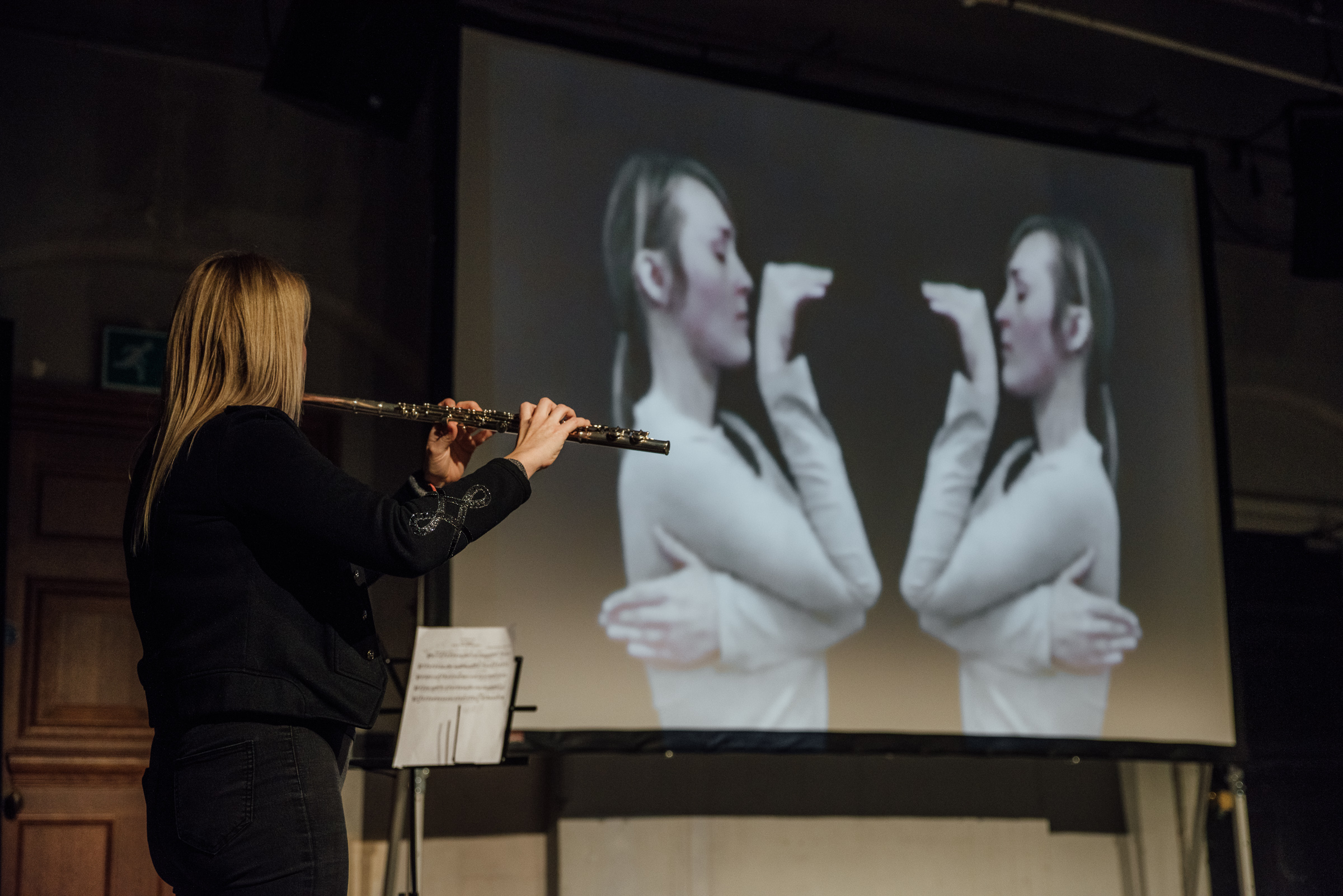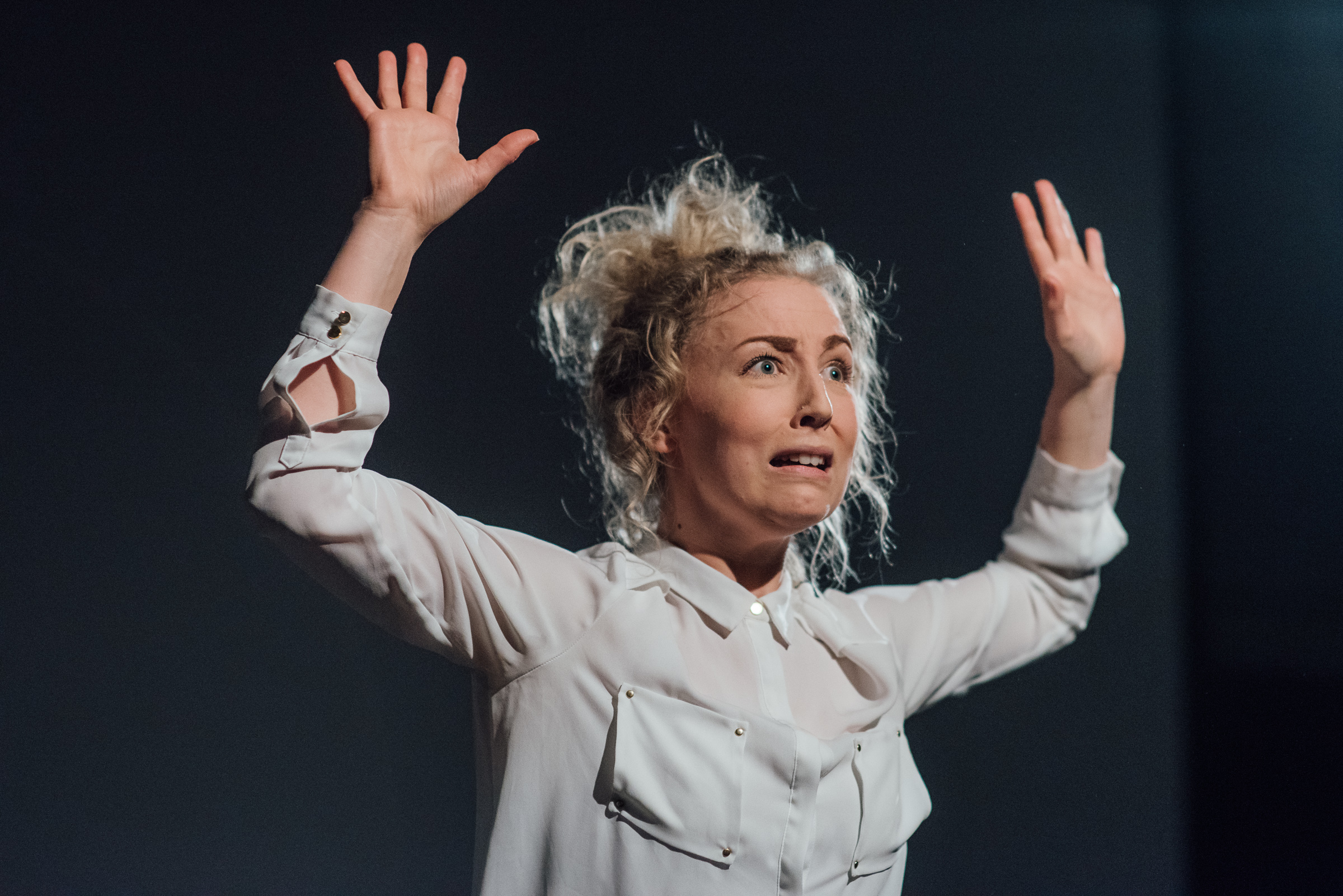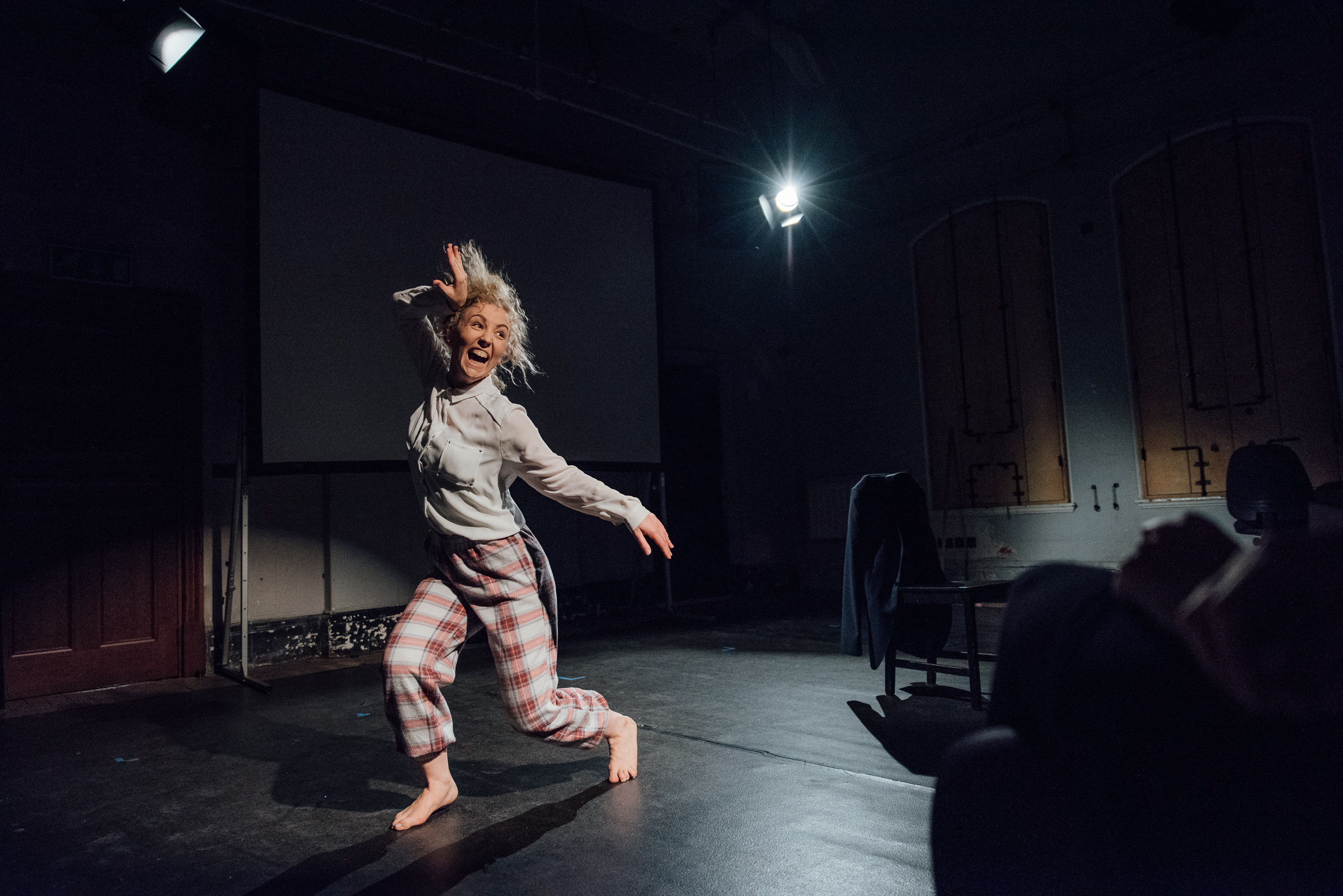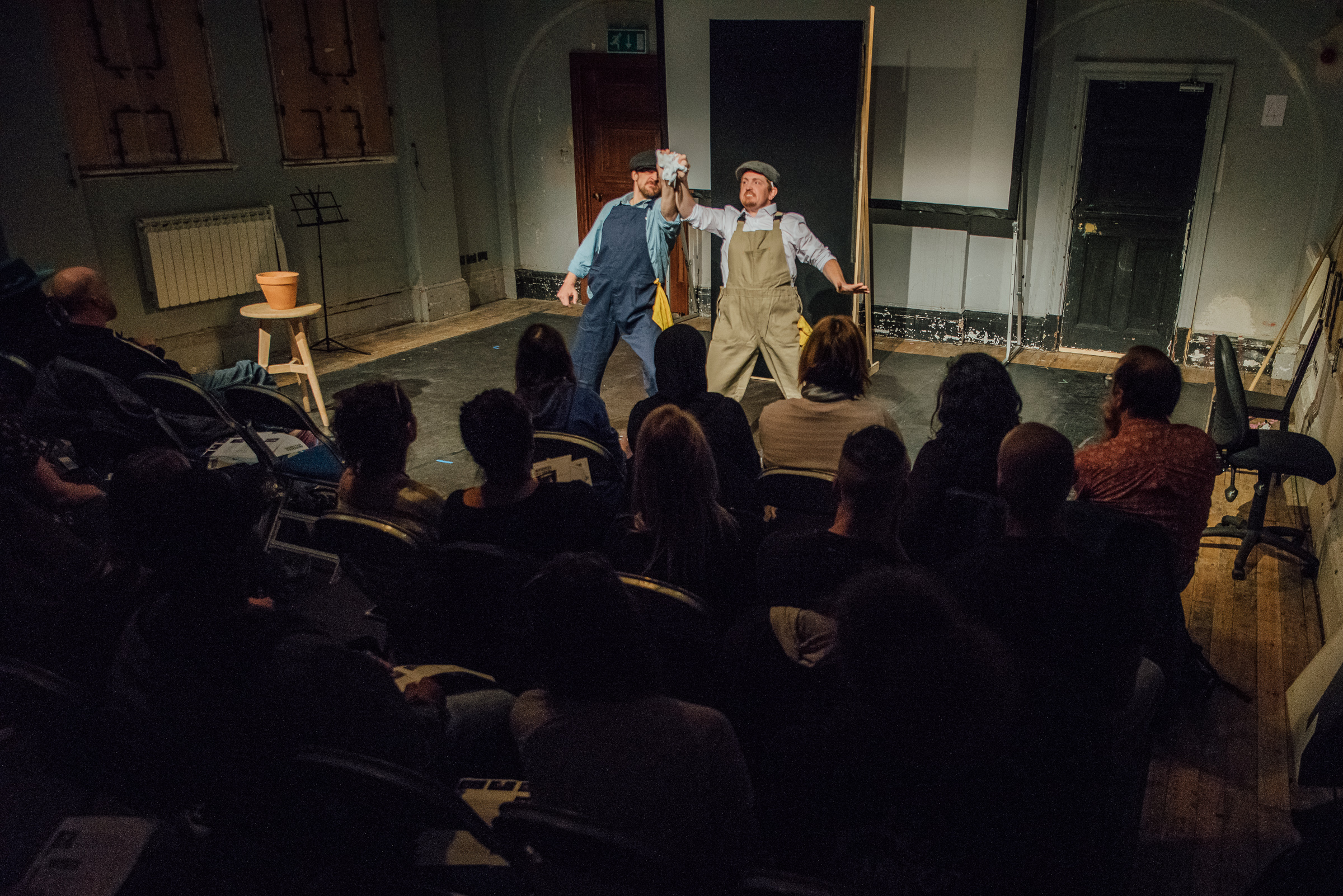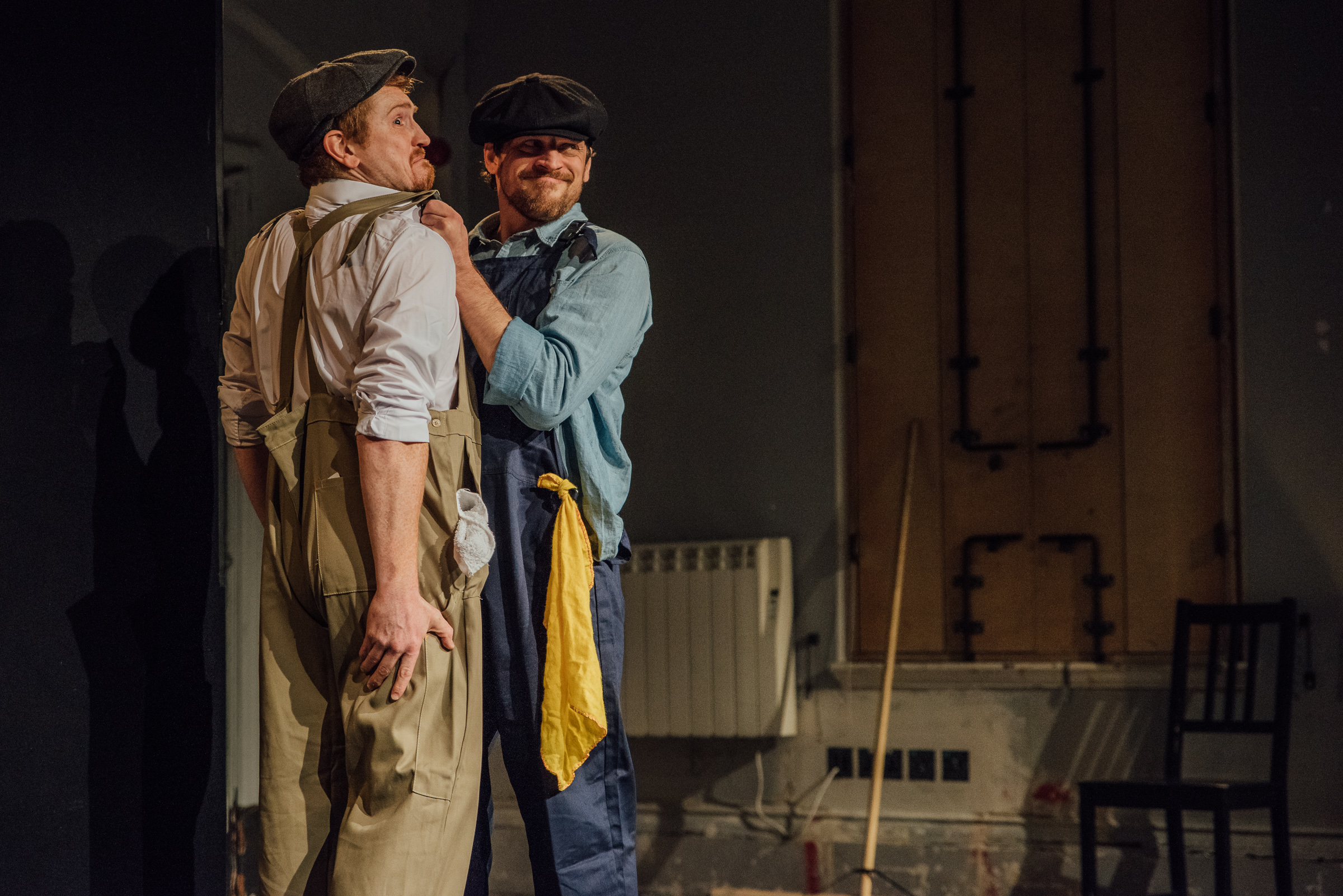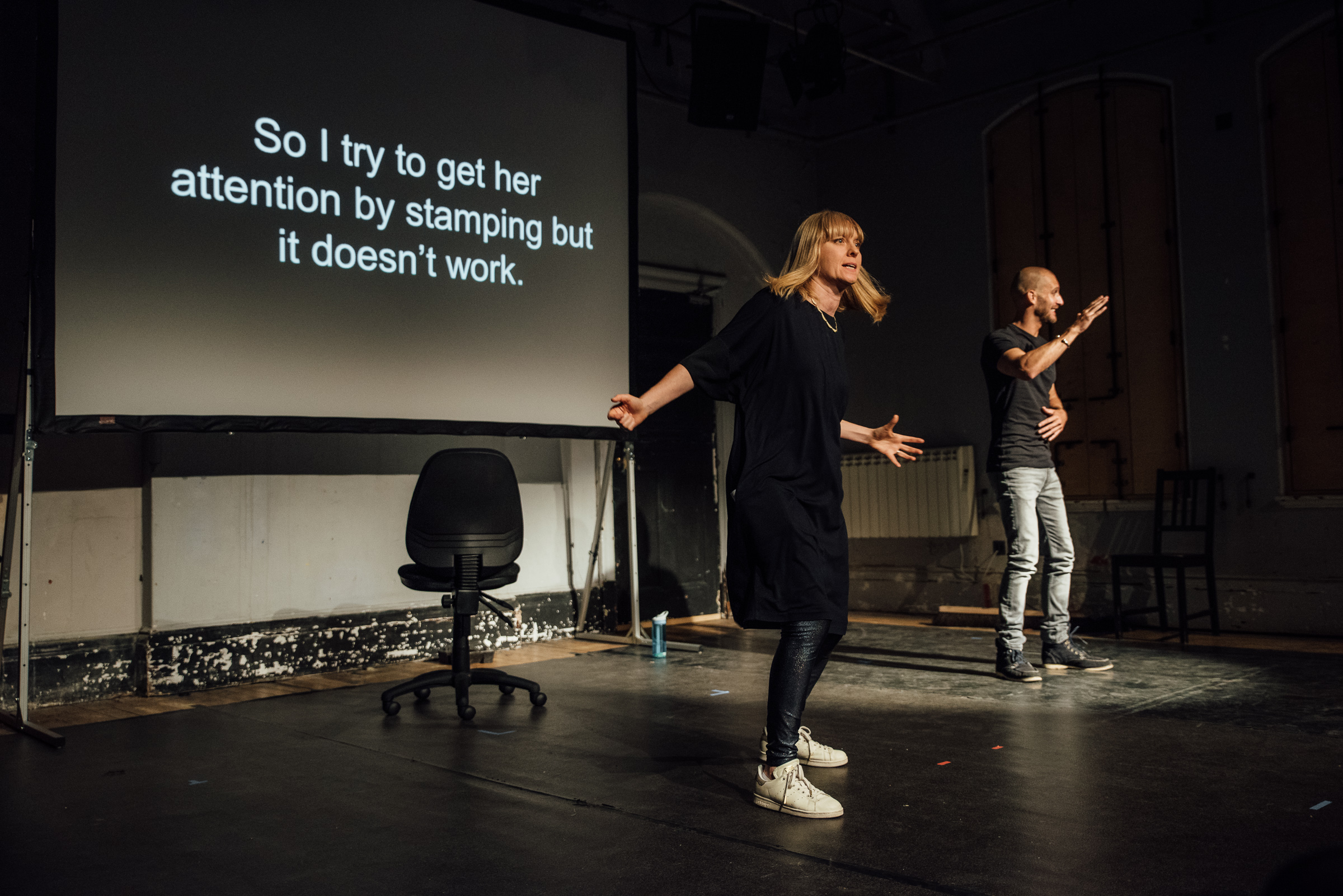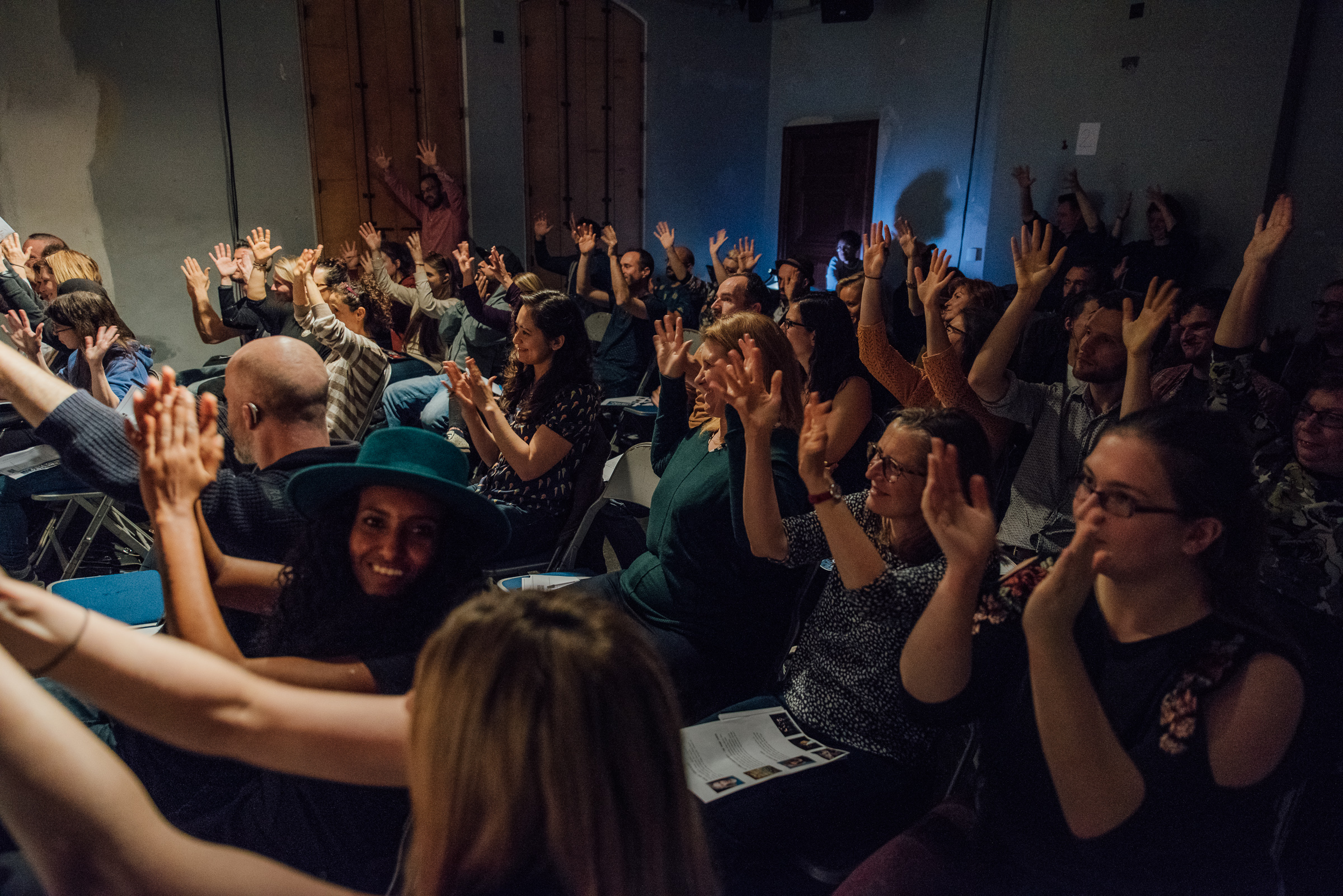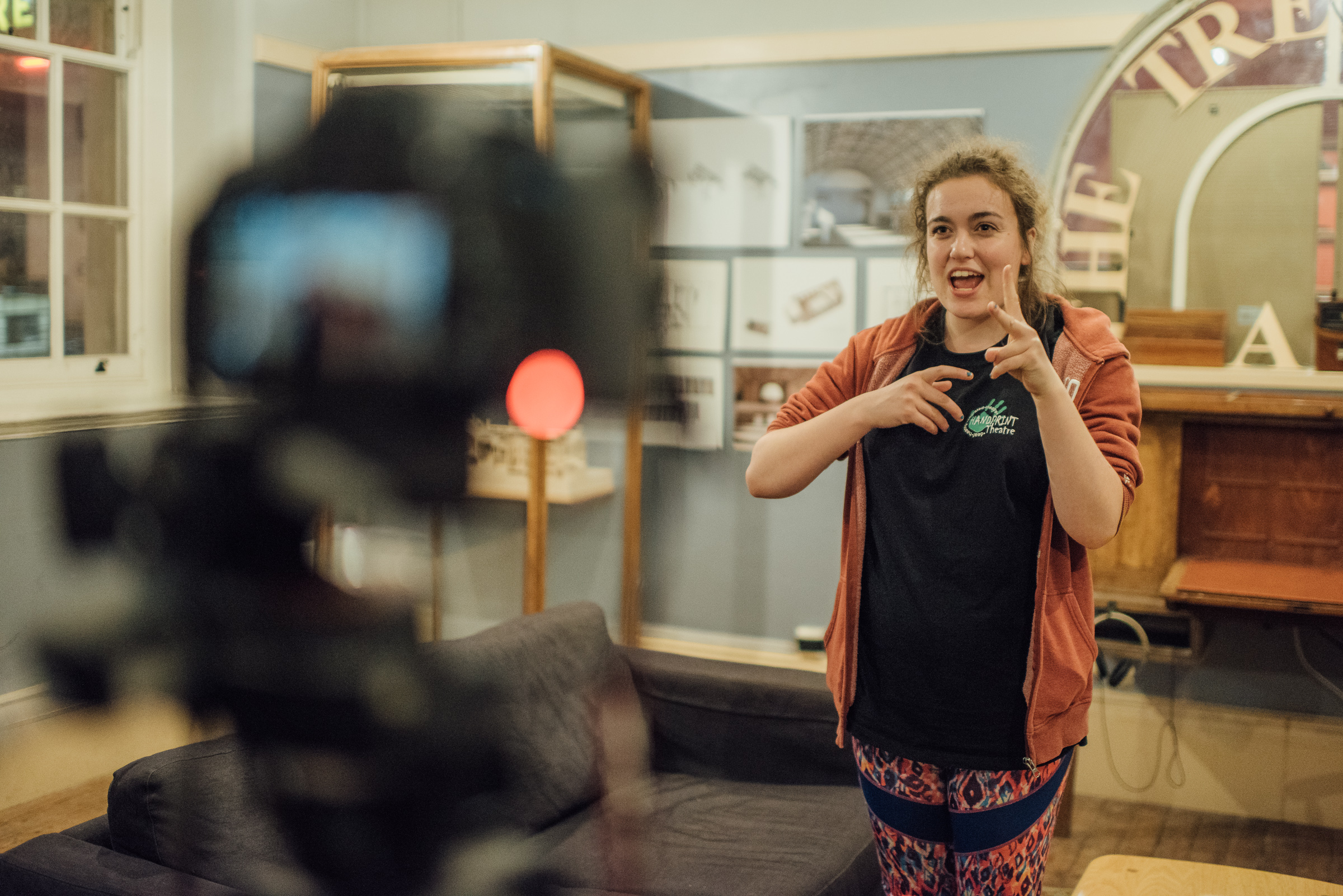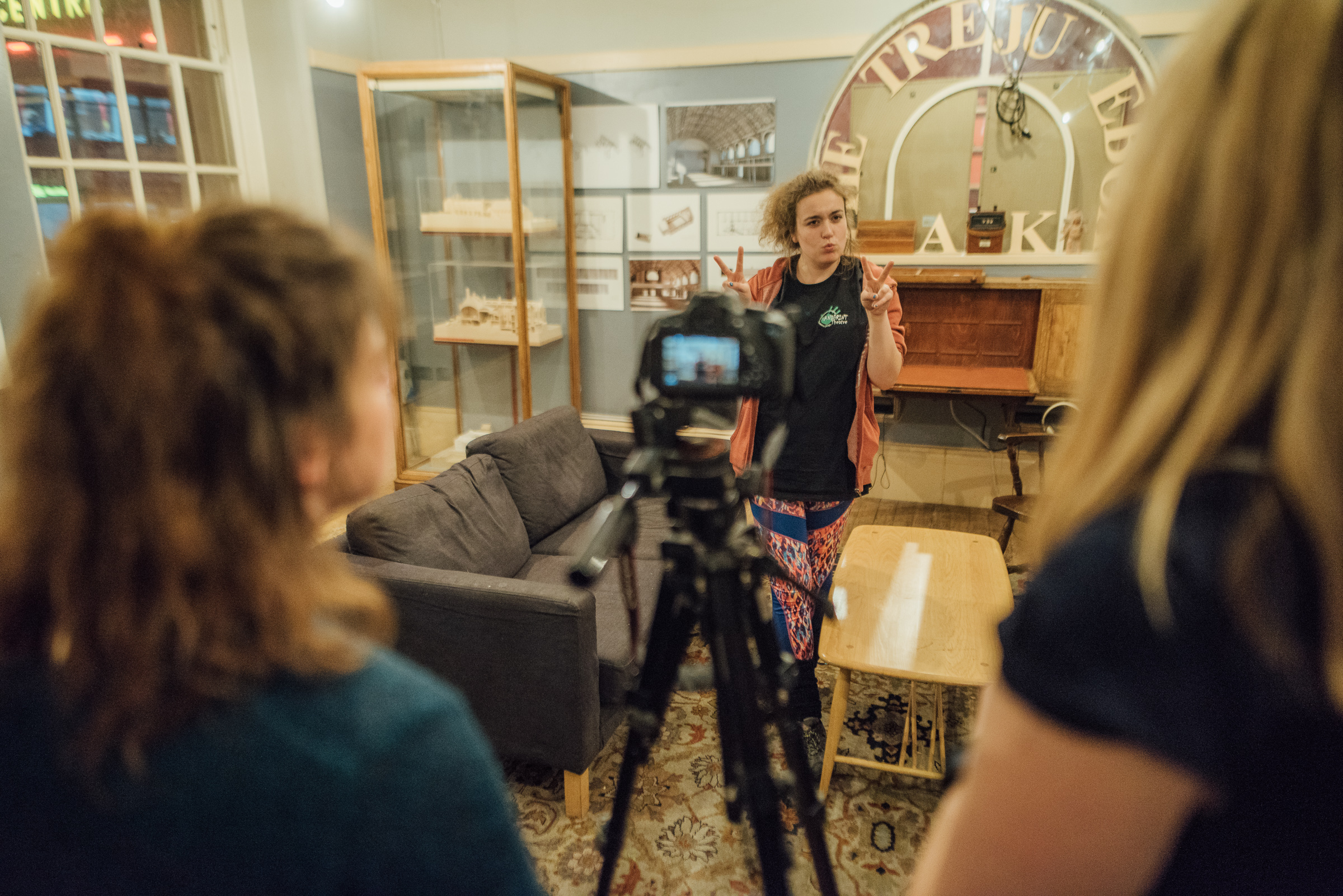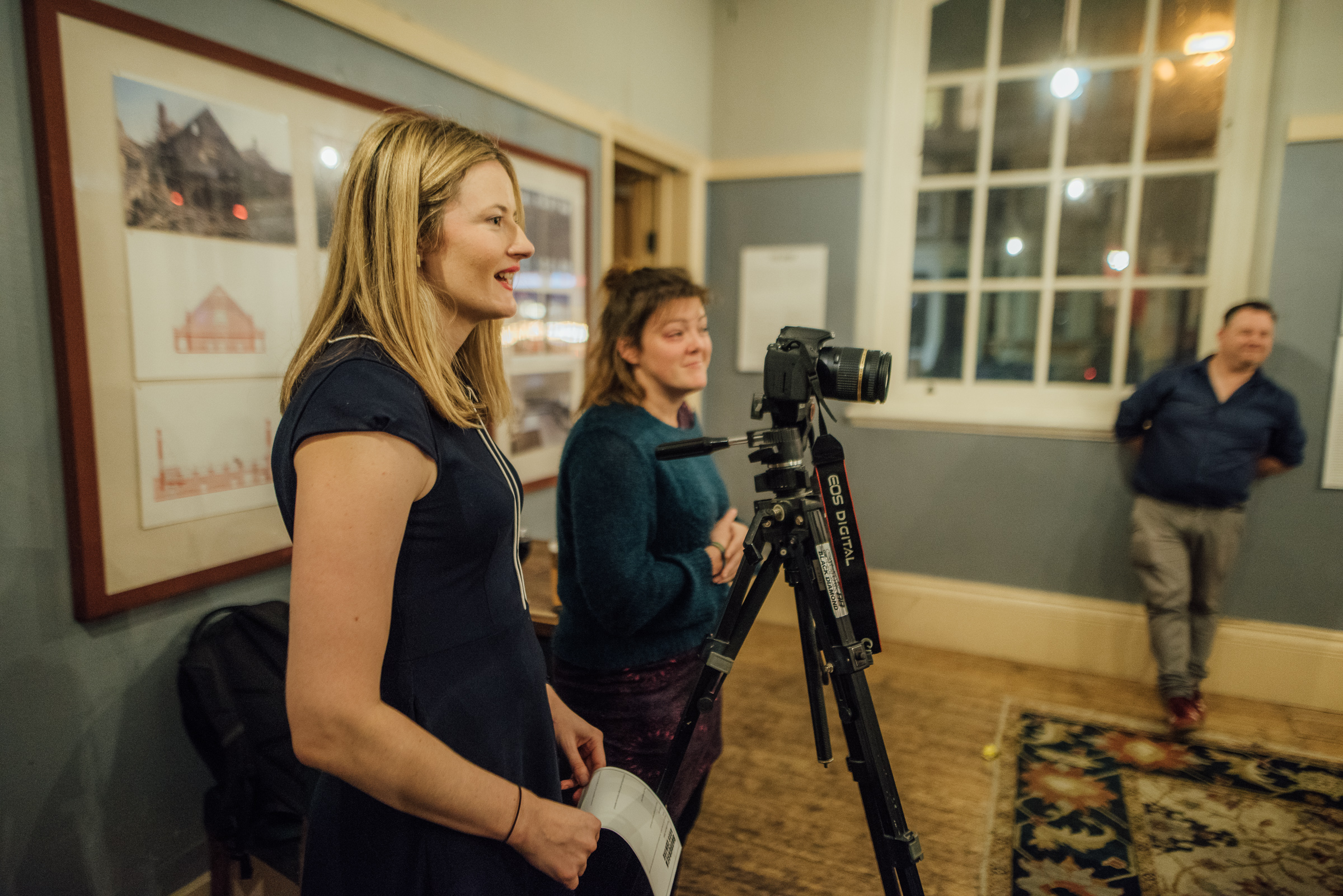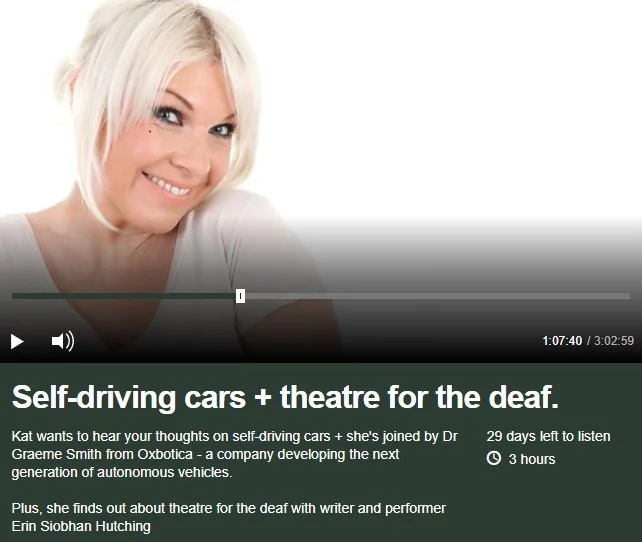LESLEY: So tell me about it – you say Mathilda asks lots of questions. So it's Mathilda and the Orange Balloon…..
ADAM: Yes, so Mathilda and the Orange Balloon. So Mathilda – she's a grey sheep, she lives in very much -
LESLEY: I don't know I didn't think to get that! (Laughs)
ADAM: (Laughs) – she lives very much grey world, and her herd essentially are just very happy with life.
LESLEY: Her flock.
ADAM: The way that they live their lives is that eat clovers, and they are just content. But Mathilda, in her brain, all these questions are going round and round, like why do we do this and why do we do that, and then suddenly she sees an orange balloon, and it's just like that light bulb moment. She sees it and she identifies with it and she's like wow, I've never seen an orange balloon, and why can't I be an orange balloon, so she wants to be the orange balloon. And from there on it, the whole show, it just takes us an journey of self discovery and self expression, and just questioning why do we do this and why do we do that, and why can't we be there? And I'm sitting here and I'm a man, but why also can't I be a rocket ship in a couple of hours time?
LESLEY: Kids are like that aren't they.
ADAM: Yeah, kids ask questions, their brains are constantly turning, and they imagine themselves to be anything, and as adults we lose that part of ourselves I think, and this play is what essentially to regain that part of ourselves to go - we can be whatever we want to be, anything is possible, if we just out our mind to it and believe it. And I think that's a really good message regardless of if you are child or an adult.
LESLEY: And what have the audiences been like? Cos they are youngsters aren't they? Do they sit fixed How do they react?
ADAM: Most of them are just completely fixated, especially with our projections – that our designed by our wonderful designer Jo – they are just so fixated on the imagery, and everything, and all the lights. But also they get so involved, it's quite an interactive show.
LESLEY: Do they get a chance to join in?
ADAM: Yeah! Well me and Mia who are the story tellers throughout the piece, we ask them the questions. We go – we don't know what this is, but what is it? And they get so involved! And they love it, and it's very interactive, they get to have a moment at the end when they get to do something really fun with us, and they are just so engaged. And what's even better is seeing hearing children and deaf children having the same engagement in the show. It doesn't matter, you just can't tell the difference. They are fully there.
LESLEY: And you've had really good audiences?
ADAM: Yeah, pretty much full. We've been touring the show now for the past couple of week's and very audience has been near enough full. Which has been wonderful.
LESLEY: I bet you always get that one lively child that you have to gently try and keep control of don't you? (both laugh)
ADAM: We encourage the children to have their voice, to have their moment. One of our shows all of the kids in the audience decided to have a dance party. (laughs) Some music comes on in the show and they all just got up and they started dancing. We were like, “you know what, let them have their moment!” This their show! But also we still need to tell the show – so you've had your moment, let's move on, let's continue. But that was so heart warming to see. I just loved watching them all. We didn't ask them to dance, there was no reason for them to be dancing! But why couldn't they dance, of course they can dance, let them dance, yeah wonderful.
LESLEY: It's a wonderful chance for you to see them go to the theatre, maybe for the first tine, And your mum took you to the west end when you were 13?
ADAM: Yea! So my mum... we'd gone and seen a few pantos when I was really young, but nothing really caught my eye until when I was 13. My mum had got a ticket to a captioned performance of Mary Poppins. She knew I was quite interested in theatre and live shows, and she took me along with her, and I was just blown away from start to finish. And it was that moment when I was like - “Wow, people actually do this for a job, so I'm going to do this for a job.” And from there on in, I was like a bull in china shop, This is what I'm going to do, and just kept doing it. And here I am doing it.
LESLEY: Those children that are coming to see your production, they may end up doing exactly what you're doing. Because of that.
ADAM: There is nothing more I can ask for really. What a wonderful gift to be able to give to children. First of all, their first ever live theatre experience, and if some of the kids do walk away with it saying this is what a wanna do, then wow, then that's just wonderful.
LESLEY: And to enjoy the magic of theatre, cos it is real magic isn't it.
ADAM: It's very magical.
LESLEY: Now I'm sorry about this, this is our key question, it's not biscuits! So you have to help yourself to a key on a fob, and then you have to answer the question.
ADAM: Right. Okay...
LESLEY: (laughing and rustling noises) What question have you got?
ADAM: What is your favourite dish or meal to cook? This is such an easy question for me because I cook it all the time!
LESLEY: Is it the only thing you can cook?
ADAM: (Laughs) No it's not! I love to cook, but for some reason every third dish is this dish, it's carbonara.
LESLEY: I love carbonara!
ADAM: I love a carbonara! I cook it for my flatmates, I cook it for my partner, I cook it for everyone, I cook it for myself, I just love it so much.
LESLEY: Are you very strict with it? What do you put in it?
ADAM: Erm, I'm kind of strict, but I don't do it I guess essentially the English way, the creamy way, I do it with the egg and the parmesan cheese.
LESLEY: Which you stir in at the last minute?
ADAM: Yeah you stir in at the last minute, you cook your pancetta and spaghetti and you chuck it in at the last minute.
LESLEY: Stir it all together
ADAM: And there you go! It's really easy!
LESLEY: I'm hungry now.
ADAM: Yeah I'm quite hungry too!
LESLEY: We'll have a bit of travel news, we'll have a bit of music and then we'll come back - and we'll talk because, if you don't mind, it's fascinating, just hearing - because I think you had an older sister who you when to talk to, but your parents you would have signed language to. It's so fascinating, and it's only now when you look back do you realise, I guess what a special time it was.
ADAM: Yeah, wonderful. Yeah yeah absolutely.
LESLEY: So Adam J Price is our guest and I''ll give you the details again in just a minute or two. Mathilda and the Orange balloon, it's the Wolsey studio tomorrow.
MUSIC AND TRAVEL NEWS BREAK
LESLEY: So the guest today Adam J Price, He's an actor performing Mathilda and the orange balloon, it's a young bit of theatre for young children tomorrow, 3 – 8 years old, it's at the Wolsey studio tomorrow morning at 11.30am. Just a few tickets left had a look earlier on - so have a look at their website and book yourself in. It's The DH ensemble, a theatre company that's lead by deaf and hearing artists so a mixture, so we were hearing, there is video, there is all sorts.
ADAM: Yeah yeah, visuals, projections, captions, spoken English, BSL – every aid we can get we use.
(Laughs).
LESLEY: You're studying BSL now aren't you? Did you learn BSL, what was it you learn?
ADAM: The thing is, growing up with deaf parents, you''d class, me as a CODA, which is a child of deaf adults – so we did do BSL growing up with my mum but we also did a bit of SSE, which is sign supported English. And also when you grow up with deaf parents you kind of create your own amalgamation
LESLEY: I was going to say, I bet they have already developed their own language.
ADAM: Yeah, you do an amalgamation. In a way, for spoken people, we create slang words within our family, stuff like that. You can kind of do the same thing with sign. So, the last couple of years, when I said I really wanted to target signing with acting, I really need to make sure my signing skill is top notch.
LESLEY: You don't want any slang signing.
ADAM: Yeah, I don't want any influences or bad habits that had as a child creep into my work. BSL is such a useful language and it's the most accessible way to communicate, so I started taking my levels again, just to make sure that my skill was good. I recently qualified and finished in my level 3, and just about to start my level 6 very soon - just to continue fine tuning the skill really, and just have it on paper to say that I can do it, cos it's sometimes just saying “I grew up with it” might not be enough.
LESLEY: I guess most people don't get to do that do that do they. It';s intriguing, because of my boys growing up couldn't say yogurt so he said “Geeyok” - and I guess it's exactly the same in signing, that you'll have your own way of doing it.
ADAM: Well what's really lovely is that I've got a nephew who is 8 years old and my mum babysits him a lot when my sisters working. And he is a great singer at 8 years old, it's wonderful, he can communicate with my mum very easily. It's lovely to see that in him, because I guess what I'm seeing in him is what happened to me when I was his age. But he has his own signs fort certain words that he'll sign to my mum that are completely wrong, but my mum understands, and she takes it, because at that moment in time that is what he believes the word to be this sign - and my mum recognising it so she doesn't question it, and as he gets a bit older she'll start to show him the right way to do things are, so your example is a perfect example for spoken people.
LESLEY: It's interesting isn't it, because they teach basic sign language to babies don't they? It isn't British sign language.
ADAM: No, it's makaton is what they teach.
LESLEY: But it shows doesn't it, that child can sign before they speak..
ADAM: Well children are sponges, for anything. Children from a very young age are able to be aware of their surrounding and take it all in. I felt like I didn't learn to sign, I just absorbed it like a sponge. That's the best way I can describe it, these methods of communication are so valuable for children, no matter what complications they may or may not have, it's just such a useful way to communicate.
LESLEY: Do you think we ought to teach... There is someone in Suffolk who believes all children should be taught makaton - but do you think there should be... well, I wouldn't have minded learning basic sign language, just so that if I ever met someone who couldn't hear, I could at least have a conversation or try and make a sign.
ADAM: I think it would such a useful thing to do in schools, juts to teach a basic sign language and then give the option if people want to process and do it further, I think it would be a wonderful thing to do. These skills are so useful. Obviously for communicating with any deaf person that you come across, but would be useful for lots of things, for job opportunities, for other things that you might want to do in your life, to have that skill, it couldn't be a bad thing.
LESLEY: There is a young lad in Suffolk who's been campaigning to have it for one of his GCSE’s. And why not?
ADAM: And exactly, why not? Maybe not so fair if it was a GCSE for me because I would have got straight through, but you know, why not have GCSE in sign language, why not have it enrolled in the school curriculum, it's such a useful way of communicating.
LESLEY: So obviously you grew up and were totally unaware really, you just learnt to communicate with your parents as any children to, but you had an older sister - who did talk to you as well. Because of course you had to learn to speak, or wanted to learn to speak, and from your point of view that was pretty essential. How did she manage?
ADAM: Well she managed because obviously our extended family are all hearing as well, so my grandparents, my aunties, my uncles, my cousins, all hearing.
LESLEY: So they all made an effort
ADAM: They all made an effort. I think when my sister when to nursery, when to school for the first time, she kind of walked in with the mentality that being deaf was the majority and being hearing were the minority – and actually she soon realised with the help of her teachers that it was quite the other way round, and what my sister had was a really special skill to communicate with her mum and dad. So I think she struggled a little bit more than maybe I did, because I had her by my side from the minute I was born speaking to me
LESLEY: So you'll have learnt both side by side.
ADAM: Yeah yeah definitely, but I don't think it was much of a struggle her her either, I think it just came quite natural for her, but yeah, I think she probably had a bit of a harder task than I did, I probably got away with a bit more help from my sister.
LESLEY: At the time I'm guessing that you didn't really notice - as you say you didn't notice there was any difference, as you've got older, has it made you aware that for people who are deaf or have a hearing problem, that's hard to get that richness of life? Cos so much of our life is based on noise, on music and television and so on, and we ought to do what you're doing and make things as accessible as possible.
ADAM: Yeah totally – I think what I've realised more than ever, is that there are ways to fix these complications, these complications in terms in terms of communication, accessibility and that sort of thing, there are ways to fix it in every part of the world really. I think that we've just got to do it basically.
LESLEY: Just get on and do it.
ADAM: We've just got to do it. For any sort of disability there are ways of accessibility, increasing accessibility, gaining more inclusivity, in their lives and stuff. I can only speak about my parents – I wouldn't want to talk on behalf of the whole Deaf community, but my parents they make the best of what they have, and they work very hard just to get on with life really and enjoy it and find the richness, even though they've lost one sense basically. But there were a lot of things growing up that I realise that it was really difficult for my mum and dad to do, without some sort of aid or help or anything, so me and my sister did a lot to help my parents growing up. Which was wonderful for us actually, because it taught us a lot about the world. And being aware, and deaf awareness, and helping other, and helping people to communicate and that sort of thing, From that is what I've taken away in my adult life, and what I've really wanted to tackle and challenge in everything I do.
LESLEY: It's all about awareness isn't it really.
ADAM: Yeah, it's complete awareness.
LESLEY: And just going to a shop can be tricky can't it - unless hearing loops are working properly and all those things, and if we don't make the effort.
ADAM: There are so many different forms of hearing impairments and that sort of thing, and each case is different, and you have to deal with each case slightly differently, but it's just about, I know it sounds silly, but it's just doing it. Its literally just doing it, and doing it with open arms. Its all anyone could ever ask for really.
LESLEY: Have they been to see what you're up to? See your production?
ADAM: My parents? Yeah they came and saw it last week, my mum cried from start to end.
LESLEY: (Laughs) she must be blow away I was going to say.
ADAM: Yeah well my mum’s a huge theatre lover anyway, she's seen every single performance I've done, she's cries at pretty much every performance I've ever done
LESLEY: (laughs)
ADAM: But yeah, for her, she felt just a sense of pride, and very proud that her son was doing something that gives back to the community. Basically.
LESLEY: She must also... because I guess if.. was she always deaf? I guess her growing up was probably toughish, because we're better now that we ever used to be, and to see the kids in the theatre.
ADAM: Well for my mum it was quite difficult. Because she lost her hearing when she was two. My grandparents are from Cyprus. They moved to England for better opportunities for children who had lost their hearing. They couldn't speak English very well. So not only was my mum trying to communicate with her parents who couldn't speak English, they also couldn't sign. But they made it work, they just supported each other and loved each other that's all.
LESLEY: She must just love the fact that this production is for kids as well so they can get involved.
ADAM: Yeah absolutely. She would have loved to have seen something like that as a child - I think she would have done it, given an opportunity, like she really would have done. I think I get a lot of acting ability from my mum, because she's one crazy lady (laughs)
LESLEY: I have another key question, and then we'll sort of gallop a bit through your career as well.
ADAM: Right, Facebook or Twitter?
LESLEY: Or as one of my guest said the other day, neither! Instagram!
ADAM: Well Facebook, twitter or Instagram – I use all three for very different things I think. I use Facebook really to keep in contact that aren't in my life like... that aren't around me all the time?
LESLEY: So people aboard, or people just friends...
ADAM: Yeah so people I see, so friends that don't live close by and stuff. Twitter I use mainly for my acting stuff.
LESLEY: Business
ADAM: Yeah business side of things, and Instagram is just for self validation. (Laughs)
LESLEY: (Laughs)
ADAM: It's just to put a picture up and feel good about yourself. Isn't that what everyone uses it for?
LESLEY: It's either that or food isn't it. We'll come back Adam and talk more in just a minute or two. Adam J Price with us. It's Mathilda and the Orange Balloon, it's an accessible piece of theatre for youngsters, age between 3-8 - it's happening at the New Wosley studio tomorrow at 11,30am, the tickets may well have all gone now, but if you want to have a quick look you can do so and maybe book yourself in.
MUSIC BREAK
LESLEY: My guest with us here Adam J Price, he's an actor, he's with Te DH Ensemble at the New Wosley Studio they are putting on Mathilda and the Orange Balloon. It;s happening tomorrow, it's an accessible piece of theatre for children, it's for deaf and hearing people, it's lead by deaf and hearing artists as well - and I've saying there is an 11.30am performance, but there is a 1.30pm and 2.30pm as well.
ADAM: 3.30pm
LESLEY: Oh 3.30 oh dear, I'm getting it all wrong (laughs) Have a look at their website and you'll get it all exactly right.
ADAM: Yeah it's all there.
LESLEY: But anyway, it's tomorrow, it's the studio, so look up the New Wosley website and then look for the studio 11.30am, 1.30pm and 3.30pm. Have to give you a bit of a gap in-between don't they, and it was selling really well when I saw earlier on. But it sound an amazing piece of theatre, and I'll get him to remind you just a little bit more about it before we finish. But I want to gallop through your life a little bit, and we've been hearing that you grow up, your parent were both deaf. Your mum took you to see Mary Poppins wasn't it? On the west end stage - which has come all the way round again isn't it.
ADAM: Yeah it's coming back this year, definitely going to go watch it cos it will be like a full circle thing for me, it would be lovely.
LESLEY: And you've always wanted to be in theatre, I think you did some stuff when you were at home. But you did go off to drama school as well didn't you?
ADAM: Yeah, I was very lucky to be offered at place at the MTA in London which I went to when I was 18, and I trained for two years. It was very much an intensive course as it was a lot of hours but wonderful training - graduated in 2012 and yeah, just worked from then on. I got an agent, and just did lots of shows and lots of different projects.
LESLEY: You've done quite a lot of travelling haven't you? Cruise ships for a start.
ADAM: Yeah I've been lucky to travel. I've been on tour in Italy, I did a residency out in Tenerife, in Crete I did a cruise ship. I've done two cruise ships actually for royal Caribbean the company, and I did Grease the Musical with them. Which was just a wonderful experience, the show itself was amazing, I loved doing the show so much.
LESLEY: So you'd do that every night do you? And go to a different port every day?
ADAM: Yeah essentially yeah! Well we didn't perform every night we performed maybe three or four times of a set cruise, but yeah - every day we were in a different port, we'd get off, get to explore, cos our working hours were in the evening, and in the evening is when the ship is sailing, so it meant that every time we were in a country we got to see it. We were very fortunate we were able to do that. On the cruise ships I've travelled so many places in the world that I just never thought that I'd be in, to be able to have the opportunity I really seized it when I got offered it. And whilst I'm young with no commitments and nothing holding me back, just go, travel the world, perform, hone my craft as well. Which is really important. Every job I do, every show I do, I'm learning more about my own skills and what I can do and bettering myself really. And with support of my agent, everyone at Michelle Blair Mnagement who are wonderful, and the continued support I get from the drama school that I went to the MTA - their policy is a college for life and it very much is that, you know, 7 years down the line I can still call them up and say “I need help! Please help me!” And they'll help me. And they give me opportunities that I didn't have before.
LESLEY: Do you know the sort of work you like doing? Or do you like to do anything?
ADAM: I love just telling stories. And I love musical theatre, it's what I trained in, I love to sing I love to dance I love to act – and I love BSL and signing. My dream, my absolute dream, would to be involved in a musical where I could use my signing. I went out to New York – when was this? Maybe three or four years ago and there was a company called Deaf West, which had put on a production of Spring Awakening on Broadway and it was all Deaf actors with Hearing actors. Full scale musical on Broadway signing in American sign language so I couldn't really follow the sign language – cos it's different if you didn't know, it's different from British sign language. Couldn't follow it, but it was the most amazing thing I'd ever seen and I walked away and I went - that is what I wanna do, that is at the top of my bucket list when it comes to being an actor.
LESLEY:So we need to get someone to do a west end musical that you can be part of.
ADAM: Yeah I feel it in the pipe line, it;s gotta happen at some point, but yeah that would be the most wonderful thing,. But I really I just love to tell stories, to work on really interesting projects, and just have a great time doing it.
LESLEY: Didn't you do a musical Hamlet? Have I got that right?
ADAM: Oh gosh, we're going right back in archives now!
LESLEY: You're only nine years in the business, so it's not that far back!
ADAM: This was my first job out of drama school – it was a production of Hamlet but it was a musical production – so yeah, it was the script of Hamlet, it wasn't Shakespeare though, it was English, modern day English, with contemporary pop music – it worked! It sounds like it wouldn't work but it did work and we did it for 8 months and it was so well received, and we toured it in Italy - so I lived in Italy for 8 months with the show. Yeah the Italian audiences loved it.
LESLEY: Was it in English or was it in Italian?
ADAM: It was in English – but they go crazy for it out there. They love theatre. And their theatres are gorgeous – the buildings are quite something I've never seen before. That was my first job out of drama school, it was an incredible experience to tour another country.
LESLEY: And you were in Crete weren't you? Was it the same sort out of thing in Crete?
ADAM: Yes, well I was just working as a vocalist out in Crete, I was doing the singing in these production shows – and it was just lovely to live in Crete for 4 months and just sing, and fill a gap of unemployment. It was nice to be singing and working on that skill, and bettering myself that way. And yeah, I've just done lots of jobs and all very different.
LESLEY: Would that be your advice to a budding actor? Just take what you can get and enjoy it and do it?
ADAM: Yeah, I think within reason. Take every experience you can get and really hone your craft. But there is sometimes companies out there that try to take advantage of actors and it's important to know your own worth as well. Because we train hard, and we pay a lot of money to train hard, but saying that – all these experiences and opportunities that come your way take them.
LESLEY: Just don't be used.
ADAM: Yeah just take them hone your craft, better yourself, get as much experience behind your belt and just got for it because it's the only way. It;s just gotta go, steam roll ahead and just do it.
LESLEY: We have time for just one more final key question
ADAM: Yeah let's do it.
LESLEY: We'll do that in just a second after the latest travel news.
TRAVEL NEWS BREAK
LESLEY: This afternoon - Adam J Price. He's at the New Wolsey Studio tomorrow - children's production Mathilda and the Orange Balloon with DH ensemble, a theatre company that's lead by deaf and hearing artists. Three productions - 11.30am, 1.30pm and 3.30pm, have a look at the website and book yourself in if there are any tickets left, cos it would be lovely to have full studios wouldn't it, full of lively youngsters.
ADAM: Yeah, that's exactly what we want.
LESLEY: And you're off to see the signs of Suffolk as much as you can fit in between now and then yeah?
ADAM: Yeah absolutely!
LESLEY: Have you been to Suffolk before?
ADAM: I've never, this is my first time. I rarely venture out of London (laughs) but I really love the opportunity to venture outside of London to see other places and explore ,so I'm really excited to look around and see what I can find.
LESLEY: And just for those who weren't with us at the beginning just to remind us, what to expect with Mathilda and the Orange Balloon.
ADAM: Yes, so Mathilda and the OrangeBalloon is a fully accessible piece of theatre with BSL, spoken English, creative captions, projections a story of self discovery, self expression, asking questions, and just a very interactive fun piece of accessible theatre for children age 3 – 8 and yeah, it's a wonderful piece of theatre.
LESLEY: Mathilda is a sheep and she lives in a grey world - until she sees an orange balloon.
ADAM: And this orange balloon changes her life. It changes all of our lives really, it's a special moment in the show.
LESLEY: And lots of interaction. It's about 45 minutes isn't...
ADAM: Yeah roughly it's about 45 minutes
